
































The R2® TechFace Pullover delivers the traditional comfort and vibes of a hoody, updated with the moisture-shedding, wind-blocking warmth of our next-level R2 material. Anglerspecific details include gusseted sleeves, a fly box-specific chest pocket, half-zip venting, a ball cap-friendly hood and a kangaroo pocket that sits over a wading belt.















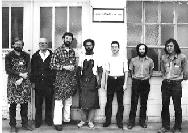

















This year, we proudly celebrate our 50th anniversary. It’s been a journey filled with fun, firsts, camaraderie, and a half-century of handcrafting high performance fly rods.
In contemplating the most fitting tribute to the anglers who fish Scott rods, the rodsmiths that craft them, and the rod designs of Harry Wilson, Larry Kenney, and Jim Bartschi, we picked one rod from each decade that exemplifies Scott innovation and, in some way, changed the way we fish.








Each was chosen from an award-winning series of Scott rods that are even more celebrated by the anglers who fish them. For those anglers, these are ‘never part with’ rods.




Rather than replicating the originals, we decided to build the blanks to spec with a resto-mod approach to finishing them. They will be instantly recognizable to Scott history buffs, but we’re introducing some new surprises by finishing them with today’s best-in-class components and construction techniques.





In celebration we offer these tribute fly rods with a heartfelt thank you to the whole Scott family.


Check them out at: www.scottflyrod.com










Board of Trustees
Chair of the Board
Terry Hyman, Washington, D.C.
President/Chief Executive Officer
Chris Wood, Washington, D.C.
Secretary
Linda Rosenberg Ach, san FranCisCo, CaliF
Treasurer
Larry Garlick, Palo alto, CaliF.
Chair of National Leadership Council
Rich Thomas, starlight, Pa
Secretary of the National Leadership Council
Paul McKay, Wheeling, W.Va
Trustees
Stewart Alsop, sante Fe, n.M.
Tony Brookfield, Park City, Utah
John Burns, neeDhaM, Mass
Amy Cordalis, ashlanD, ore.
Josh Crumpton, WiMberley, texas
Mac Cunningham, basalt, Colo
R. Joseph De Briyn, los angeles, CaliF
Paul Doscher, Weare, n h
Larry Finch, Wilson, Wyo
Susan Geer, gilbert, ariz
Peter Grua, boston, Mass
Chris Hill, Washington, D.C./haines, alaska
Gregory McCrickard, toWson, MD
Phoebe Muzzy, hoUston, texas
H. Stewart Parker, ChaPel hill, n.C.
Al Perkinson, neW sMyrna beaCh, Fla
Greg Placone, greenVille, s.C.
Candice Price, kansas City, Mo
Donald (Dwight) Scott, neW york, n y
Kathy Scott, norriDgeWoCk, Me
Judi Sittler, state College, Pa
Joseph Swedish, silVerthorne, Colo
Blain Tomlinson, long beaCh, CaliF
Terry Turner, glaDstone, ore
Leslie Weldon, benD, ore
Jeff Witten, ColUMbia, Mo./elkins, W.Va
Geofrey Wyatt, santa barbara, CaliF
Chair Rich Thomas Secretary
Paul McKay
arizona, Tom Goodwin
arkansas, Melinda Smith
ColoraDo, Greg Hardy
CaliFornia, Trevor Fagerskog
ConneCtiCUt, Beth Peterson
georgia, Carl Riggs
iDaho, Ed Northen
illinois, Mark Wortsmann
ioWa, Tom Rhoads
kentUCky, Gene Slusher
Maine, Tammy Packie
MassaChUsetts, Bill Pastuszek
MiChigan, Greg Walz
MiD-atlantiC, Noel Gollehon
Minnesota, Randy Brock
Montana, Mark Peterson
neW haMPshire, John Bunker
neW Jersey, Peter Tovar
neW MexiCo, Jeff Arterburn
neW york, Jeff Plackis
north Carolina, Mike Mihalas
ohio, Matt Misicka
oklahoMa, Scott Hood
oregon, Peter Gray
ozark (ks/Mo) James Soukup
PennsylVania, Russ Collins
soUth Carolina, Michael Waddell
tennessee, Mark Spangler
texas, Joe Filer
Utah, Jeff Taniguchi
VerMont, David Deen
Virginia, Eric Tichay
Washington, Andrew Kenefick
West Virginia, Paul D. McKay
WisConsin, Linn Beck
WyoMing, Jim Hissong
State Council Chairs
arizona, Alan Davis
arkansas, Michael Wingo
CaliFornia, Trevor Fagerskog
ColoraDo, Barbara Luneau
ConneCtiCUt, Rich Mette
georgia, Rodney Tumlin
iDaho, Matthew Woodard
illinois, Dan Postelnick
ioWa, David Klemme
Coldwater Conservation Fund Board of Directors 2025
President
Jeffrey Morgan, neW york, n y
Executive Committee
Joseph Anscher, long beaCh, n y
Philip Belling, neWPort beaCh, CaliF
Stephan Kiratsous, neW york, n y
Stephen Moss, larChMont, n y
Directors
Peter and Lisa Baichtal, saCraMento, CaliF
Daniel Blackley, salt lake City, Utah
Douglas Bland, ChesaPeake City, MD.
Stephen Bridgman, WestFielD, n.J.
Mark Carlquist, los gatos, CaliF
Gregory Case, PhilaDelPhia, Pa
Benjamin Clauss, greenVille, s.C.
Bonnie Cohen, Washington, D.C.
James Connelly, neWPort beaCh, CaliF
Jeremy Croucher, oVerlanD Park, kan
Matthew Dumas, Darien, Conn
Rick Elefant and Diana Jacobs, berkeley, CaliF
Glenn Erikson, glorieta, nM
Renee Faltings, ketChUM, iDaho
John Fraser, norWalk, Conn
Matthew Fremont-Smith, neW york, n.y.
Bruce Gottlieb, brooklyn, n y
John Griffin, brooklyn, n y
Robert Halmi, Jr., neW york, n y
William Heth, eaU Claire, Wis
Kent and Theresa Heyborne, DenVer, Colo
Kent Hoffman, oklahoMa City, okla
Frank Holleman, greenVille, s.C.
Braden Hopkins, Park City Utah
James Jackson, hoUston, texas
Tony James, neW york, n.y.
Jeffrey Johnsrud, neWPort beaCh, Cali
Jakobus Jordaan, san FranCisCo, CaliF
Matthew Kane, boUlDer, Colo
James Kelley, atlanta, ga
Peter Kellogg, neW york, n y
Andrew Kenefick seattle, Wash
Steven King, Wayzata, Minn
Lee Lewis, PhilaDelPhia, Pa
Cargill MacMillan, III, boUlDer, Colo
Ivan & Donna Marcotte, asheVille, n.C.
Michael Maroni, bainbriDge islanD, Wash
Jeffrey Marshall, sCottsDale, ariz.
Heide Mason, yorktoWn heights, n.y.
Paul McCreadie, ann arbor, MiCh
Gregory McCrickard, toWson, MD
J. Thomas McMurray, JaCkson, Wyo
kentUCky, Mike Lubeach
Maine, Matt Streeter
MassaChUsetts, Josh Rownd
MiChigan, Gabe Schneider
MiD-atlantiC, Randy Dwyer
Minnesota, Brent Notbohm
Montana, Brian Neilsen
neW haMPshire, Michael Croteau
neW Jersey, Marsha Benovengo
neW MexiCo, Marc Space
neW york, Cal Curtice
north Carolina, Brian Esque
ohio, Scott Saluga
oklahoMa, Bridget Kirk
oregon, Mark Rogers
ozark (ks/Mo) Brian Carr
PennsylVania, Leonard Lichvar
tennessee, Ryan Turgeon
texas, Chris Johnson
Utah, Scott Antonetti
VerMont, Jared Carpenter
Virginia, Jim Wilson
Washington, Pat Hesselgesser
West Virginia, Eugene Thorn
WisConsin, Scott Allen
WyoMing, Kathy Buchner
Daniel Miller, neW york, n y
Robert & Teresa Oden, Jr., hanoVer, n h
Kenneth Olivier, sCottsDale, ariz
H. Stewart Parker, ChaPel hill, n.C.
Anne Pendergast, big horn, Wyo.
Michael Polemis, olD ChathaM, n.y.
Gregory McCrickard, toWson, MD
Adam Raleigh, neW york, n y
John Redpath, aUstin, texas
Michael Rench, CinCinnati, ohio
Steven Ryan, Wilson, Wyo
Leigh Seippel, neW york, n y
Paul Skydell, bath, Maine
Gary Smith, st loUis, Mo
Robert Strawbridge, III, Wilson, Wyo
Paul & Sandy Strong, lakeMont, ga
Margeret Taylor, sheriDan, Wyo
Robert Teufel, eMMaUs, Pa.
Andrew Tucker, larChMont, n y
Andrew Tucker, Vero beaCh, Fla
Deacon Turner, DenVer, Colo
Jeff Walters, sCottsDale, ariz
Maud and Jeff Welles, neW york, n y Tyler Wick, boston, Mass
Geofrey & Laura Wyatt, santa barbara, CaliF
Daniel Zabrowski, oro Valley, ariz



[ Chris Wood ]
We have just been through a consequential election. Change is afoot. What never changes, however, is our commitment at Trout Unlimited to advocate for the lands and waters that sustain our great nation.
The new faces in Washington may make some campaigns more challenging. The good news is that all our campaigns are place-based and emanate from a passion by local people to protect places they live and love.
For example, the desire to protect Bristol Bay begins in dozens of small Alaska native villages, the spokes of which extend outward to the commercial fishing industry and to the state capital.
Following the 2016 election, we engaged the Trump Administration to protect Bristol Bay. Our advocacy was key in persuading them to deny the key permit for the Pebble Mine. Then, when President Biden took office in 2021, we worked with his administration to set Bristol Bay off limits to industrial-scale mining.
That is TU in a microcosm.
Many conservation organizations claim to be bipartisan. We are non-partisan.
We bridge divides. In places such as the Upper Colorado River, where wild trout populations were declining, we moved from a litigious position with the water companies whose reservoir was to blame, to one of collaboration. A few months ago, we joined them in celebrating the completion of a mile-long bypass of a wild trout river around a reservoir that provides water to people in the Front Range.
TU bleeds partnerships. Consider the recent removal of the four Klamath dams. American Rivers, CalTrout, a bevy of tribes and an alphabet soup of state and federal agencies worked with us to make that a reality. No politician in America, regardless of their party affiliation, can oppose those kinds of coalitions.
Let’s keep building them.
Some may worry that public funding for conservation, such as the historic investments made possible by the infrastructure law, may be “clawed back” or dry up.
Maybe, but money flows to things people want, and the fact is that people like what we do. I was recently with U.S. Rep. Glenn “GT” Thompson (R-PA) and two awesome TU staff members, Brian Cooper and Scott Koser. We toured Beech Creek, a stream in Pennsylvania severely damaged by acid mine drainage. As we walked away from the river, Congressman Thompson looked over at Scott and Brian and said, “Let’s recover this river. Let me know how to help.”
The idea that we can leave a healthier land legacy than the one we inherited is fundamentally non-partisan. So is reducing a community’s drinking water supply filtration costs by protecting upstream roadless and wilderness areas. So is allowing a river to access its floodplain to reduce the energy of the next flood for a downstream community. So is creating tens of thousands of high-paying family-wage jobs across rural America through restoration.
Regardless of what party is in the White House, TU will always push them to maintain our nation’s sacred commitment to America’s lands and waters.
I’ll end by echoing something I have said before.
Our work, our entire approach to collaborative stewardship, is more vital—more needed—in this country than ever before. The voices of sportsmen and women will be ever more central in the coming years. So few issues bring the country together today. Conservation—the notion that we can take specific actions today, to make the world a better place for our kids tomorrow—may be the one issue that can help unite an otherwise divided nation.


EDITOR
Kirk Deeter
DEPUTY EDITOR
Samantha Carmichael
EDITOR-AT-LARGE
Erin Block
Trout Unlimited
1700 N Moore Street Suite 2005
Arlington, VA 22209-2793
Ph: (800) 834-2419 trout@tu.org www.tu.org
DESIGN
grayHouse design jim@grayhousedesign.com
DISPLAY ADVERTISING
Zack Dingus zachary.dingus@tu.org (571) 919-8083
TROUT UNLIMITED’S MISSION: To conserve, protect and restore North America’s coldwater fisheries and their watersheds.
TROUT (ISSN 0041-3364) is published four times a year in January, April, July and October by Trout Unlimited as a service to its members. Annual individual membership for U.S. residents is $35 Join or renew online at www.tu.org.
TU does occasionally make street addresses available to like-minded organizations. Please contact us at 1-800-834-2419, trout@tu.org or PO Box 98166, Washington, DC 20090 if you would like your name withheld, would like to change your address, renew your membership or make a donation.
Postmaster send address changes to:
TROUT Magazine
Trout Unlimited
1700 N Moore Street Suite 2005 Arlington, VA 22209-2793


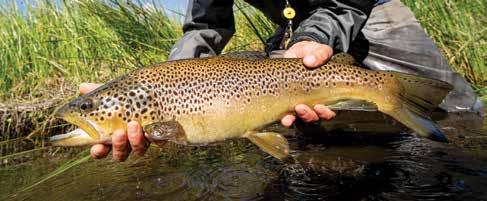

World-class, dry-fly fishing for wild trout in some of Patagonia’s best water, including 120km of private water available to all our guests. Experienced, veteran fly-fishing guides. Spectacular accommodations and cuisine at our 2 lodges.
www.cincorioslodge.com info@cincorioslodge.com +56 9 84486974
[ Kirk Deeter ]
When people ask me how long I’ve been with TU, I don’t count in years. I count in issues of the magazine. And with this edition of TROUT, I just turned 50. Fifty issues. I didn’t see it coming back when I started, and to be honest, I didn’t expect it to last this long. But I’m deeply grateful that it did. Not only am I still plugging; I’m more energized than ever. I think we’re just hitting stride. And none of it would have been possible without so many others—from my deputy Samantha Carmichael and art director Jim Gray (both of whom I “inherited”)… to editor-at-large Erin Block, Tim Romano, Josh Duplechian and countless other contributors. Of course, that “Guy on Page 6” has had a lot to do with it, as have the many staff members of TU who literally work every day to make this trout- and salmon-centric world of ours better. It’s easy to do the work when you know the product serves a greater good, and you’re surrounded by great people who want to make a difference. Most of all, it’s an honor to make a magazine for readers like you—an audience of the most dedicated anglers in the world who understand that giving back and taking care of the resources is a much more important part of the fishing conscience than “how many” or “how big.” Thank you, from the bottom of my heart for reading, and for all you do.





The core of the Hardy performance reel range, Averon delivers the quality and reliability that are the hallmarks of the Hardy brand. The lightweight yet durable design has been carefully crafted to blend performance, fishability and long-term reliability into a stylish large arbour design.
For over 150 years Hardy has been at the forefront of reel design and this newest addition is built to the same exacting



I know a creek in the Blue Ridge Mountains—a classic, delicate Appalachian creek like so many others there. Hurricane Helene overwhelmed them all and sent waters into surging confluences that crushed people, families and livelihoods. And like the people of the region, this is a story of a creek bending but not breaking.
On this beautiful autumn day, I stand shoveling rock and gravel from the debris field to rebuild the access ramp to a bridge. The bridge survived, though its steel beams bowed under the force of water. As I shovel, I glance more than once up into the first pool above the bridge. It often graces me
with a heavenly, wild brown trout if I can coax a cast under the branches and earn a drift where the trout hide. Today is not the day to chase them though. As is true for many communities across North Carolina and Tennessee, today is a day to clean up and heal. Rest the fish, rest the heart. I wink knowing
I will be back to try that pool again, just not today, and not for some time. Those little warriors deserve a break, if they made it through the storm at all. The stream bed was scoured by the storm and dumped on this unprecedented floodplain. Were the spawning gravels lost forever? Would the resident trout be able to spawn and carry on, if they are there at all? Perhaps, just perhaps, enough gravel had been moved down from up on the mountain to replace what was washed away—a sort of eons-old conveyor belt that has been
eroding the Appalachians from their original Rocky Mountain heights. A couple days later, I walk over the bridge and up the trail to see what chaos Mother Nature wrought upstream. I find changes that are profound, but, strangely, not devastating. The river is its placid, sheepish self all over again— gently gurgling and foaming here and there as it makes its way downhill. The plunge pools still plunge, just in different places—maybe a bit left or right of where I last left them, or slightly up or downstream from where they used to be. There are about as many pools as before, just a deck reshuffled. Some riffles are now pools, and some pools are now riffles. Undercut banks are more undercut, and several trees tilt precariously or are already in the water. At one favorite spot, there is a downed tree blocking the casting lane to the best water. However, that is my problem, not the trout’s problem. At least they have a new spot of refuge, if they are there at all.
A soft sun is flashing the water along with the quartz and mica among the exaggerated rock piles. I don’t see any fish finning. I don’t want to. I want them to have found new comfortable hiding places. I don’t want them laid bare, exposed and vulnerable like so many folks of these mountains. I will come back and look for them with my 6-foot, 3-weight eventually. I pray forward to that day when a healthy trout surges to a good drift.
It is all a prayer for resilience: for people, for streams, for livelihoods, for fish. The fisherfolk won’t forget these places. They might not live in the communities, but they know where they are, with all their charms and serenities. They will
Much as these headwaters and blue lines started the flood, may they also be among the first sources of healing and renewal. There will come a day when I put a fly in all the old places and all of the new places too, and the trout will rise.

lend a hand, a shovel, a chainsaw, a pickup truck and a hug or handshake. And in their awkward way, they will help nurse these towns back to health at the markets, the country stores, the motels and the fly shops. They will help nudge them forward and slowly push back the nightmares.
The fishing community certainly won’t fix everything—far, far from it. Yet we can try and try we should. Downstream at Asheville and its surrounding counties will be a much longer and sadder recovery, and fishing is appropriately nowhere near a priority right now. We can help with boots on the ground or dollars in the mail—whatever we can do. Healing and rebuilding will take time. Yet through it all, there remains an undeniable strength is in these hills. That strength and faith will bring a hard-earned revival to each place in its own time.
As for the fishing, I am not a biologist or hydrologist or entomologist. I am just a guy rooting for this place, its people and its streams, and all the proud communities like it up and down Appalachia. It might be thin for a few seasons, but it is not over for this creek beside me. Much as these headwaters and blue lines started the flood, may they also be among the first sources of healing and renewal. There will come a day when I put a fly in all the old places and all of the new places too, and the trout will rise. Like the families and communities of these mountains that are healing and recovering, they will rise.
To donate, see the North Carolina Community Foundation Disaster Relief Fund, The East Tennessee Foundation Neighbor to Neighbor Disaster Relief Fund and/or The Guide Relief Program.
Little Mountain is a magical high desert region of over 500,000 acres in southwestern Wyoming’s Sweetwater County. This habitat of badlands, aspen groves and pine forests— simultaneously rugged and fragile—is one of Wyoming’s most sought-after hunting grounds for mule deer and elk and holds intimate streams that shelter native Colorado River cutthroat trout.
The area is also home to over a decade of collaborative watershed restoration work led by Trout Unlimited, as well as grassroots advocacy to ensure these native trout strongholds are not degraded by oil and gas development.
In 2008, local hunting and fishing groups banded together, forming the Greater Little Mountain Coalition, to push back on new oil and gas leasing until the Bureau of Land Management (BLM) put in place a forwardlooking plan for oil and gas development that balances native trout and wildlife conservation with opportunities
for responsible resource extraction. In August, these efforts were highlighted when the BLM issued a new management plan for managing 3.6 million acres of public lands in the Rocks Spring Field Office, which includes the Greater Little Mountain Area.
While still subject to a protest period and Governor’s consistency review before a final record of decision is issued, the new plan reflects the majority of the coalition’s recommendations and vision for Greater Little Mountain, including strong protections for all five streams that host conservation populations of Colorado River cutthroat trout. Meanwhile, the plan leaves 70 percent
of the field office open to oil and gas leasing.
In protecting these native trout watersheds, the plan also protects restoration investments. Since 1990, $10 million has been invested in collaborative habitat restoration projects. Maintaining these investments is not only commonsense, it mirrors the concept of ‘restoration leasing’ that was adopted last summer in the BLM’s Conservation and Landscape Health Rule. Under this new policy, the BLM would not allow incompatible uses, such as new oil and gas leases, in areas where restoration leases promote investments in land and watershed restoration.
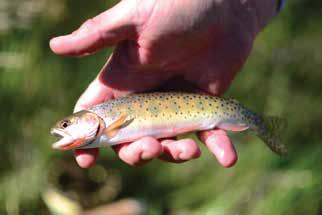
The word “balance” is thrown around a lot in the world of natural resource management, but it’s rare when balance is actually achieved. Thanks to a decade and a half of advocacy, Little Mountain and its native trout have a bright and balanced future.
—Corey Fisher




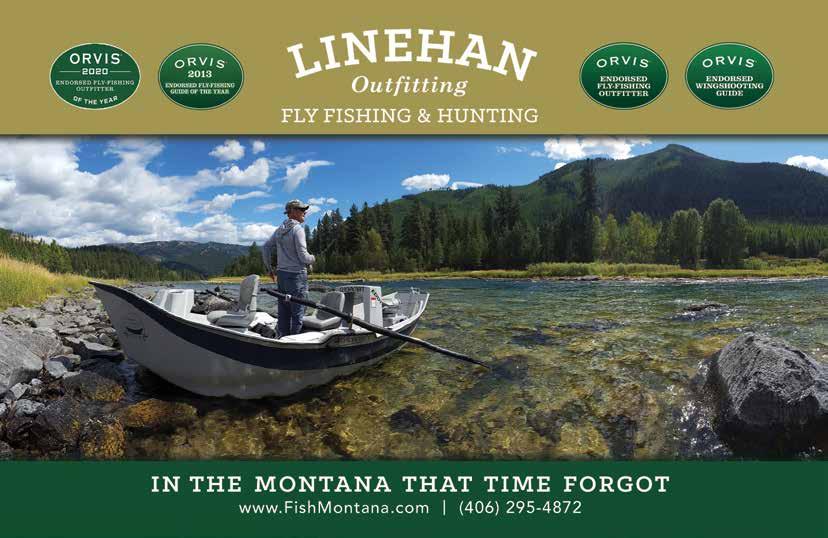
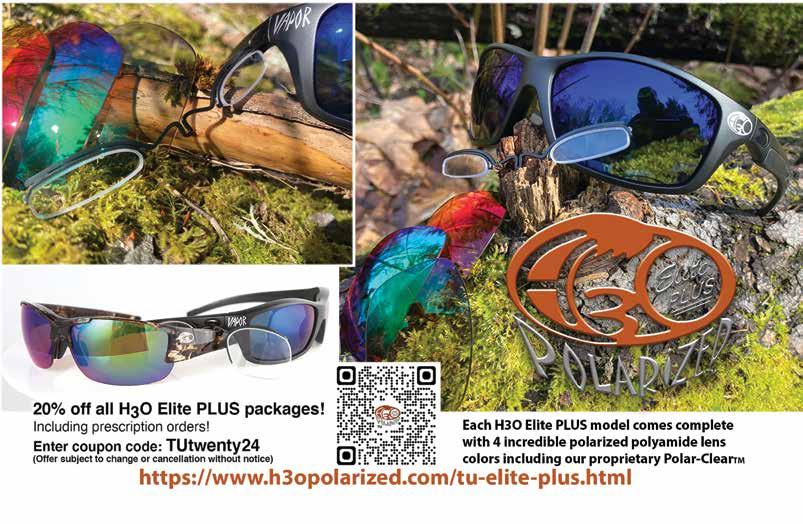
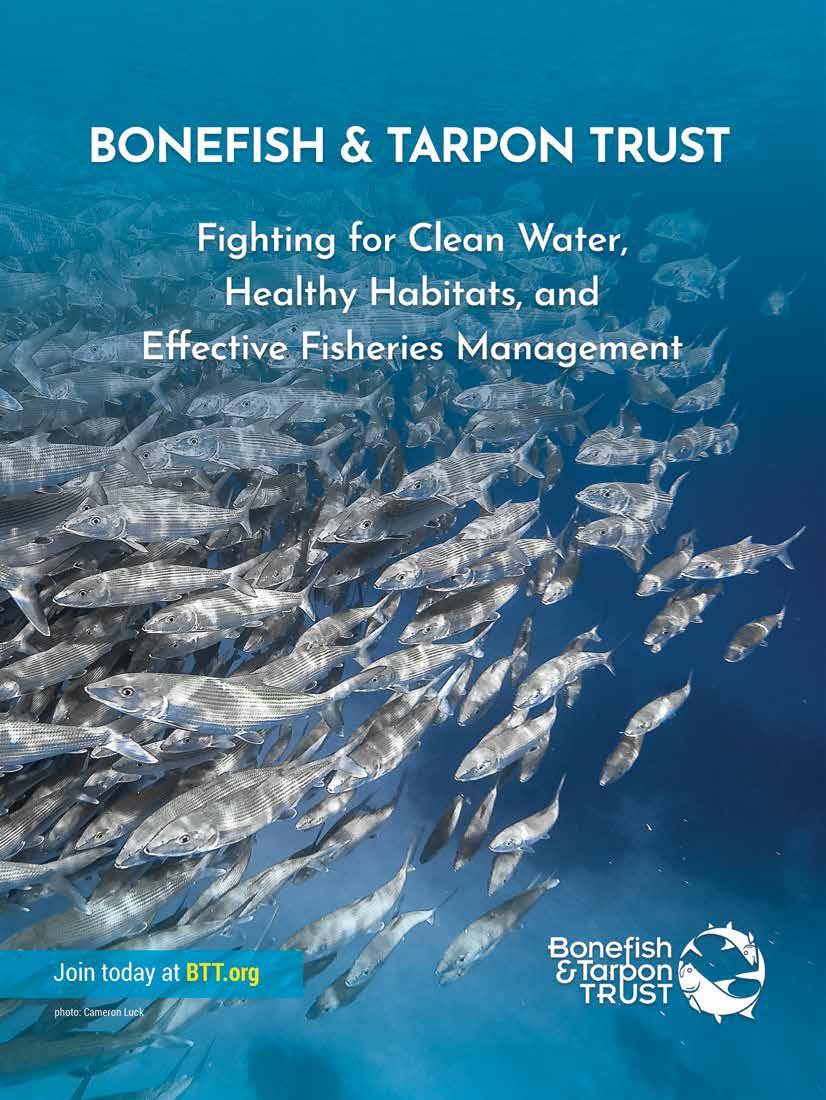

It was 4:45 in the morning, deep in the Wind River range. The wind howled, and the rain pelted the river with a vengeance. This was the 2024 TU Costa 5 Rivers Ambassador Summit, and night one was off to a great start.
Just a few hours before, 10 college students arrived at the airport and shook each other’s hands for the first time. They came from Clemson, Lees McRae College, Georgia Tech, Auburn, Texas A&M, Gonzaga, Western Washington University, University of Wisconsin Stevens Point and Colorado State University. While they may be from every corner of the country, they had one thing in common—they are leaders of their college fly-fishing clubs. These anglers are the future of coldwater conservation, and their primary goal is to protect ecosystems.
The TU Costa 5 Rivers program is a network of nearly 80 TU affiliated college fly-fishing clubs, the result of a decade-long partnership between
Trout Unlimited and Costa Sunglasses. Each of these college fly-fishing clubs is led by a team of student leaders that work to bring the TU mission to life on their campus. The Ambassador Summit is a weeklong event that involves some of the most impressive club leaders to
engage with TU conservation projects, teach the sport of fly fishing and learn valuable leadership skills. This past summer, the event took place in Wyoming in partnership with Indifly and the Shoshone and Arapaho Fish and Game Department.
Continued on next page

Continued from previous page
After the thunderstorm rolled through, the students crawled out of their tents, many of them for the first time west of the Mississippi. During the first two days of the Ambassador Summit, the 5 Rivers leaders participated in a conservation project we all know too well… trash cleanup. At the end of it all, the students and Wind River Fish and Game removed over two truckloads of trash.
With the trash cleaned up, the students were eager to give back in a different way. Learning to fly fish is a daunting task and sometimes all it takes is one lesson with a more experienced angler to bring it all together. 5 Rivers leaders across the country are these experienced anglers who bring an impressive number of new anglers to the sport of fly fishing each year. On the Wind River Reservation, the students were tasked with putting on a free fly-fishing class for anyone who wanted to join. Nearly 30 people showed up, and the energy was contagious as many people caught their first fish on a fly rod.
Will Scott, Clemson University
“My love for fly fishing used to be just that, a love for fly fishing. After the 5 Rivers Ambassador summit, I developed a love for conservation and impacting other communities.”
The TU mission is at the heart of each 5 Rivers leader, and at the Ambassador Summit, the students had the opportunity to get some hands-on experience with a TU project. On Muddy Creek, part of the Green River watershed, there is an effort led by TU staff to improve habitat for native Colorado Cutthroat trout. To do this, the students constructed beaver dam analogs (BDAs), human made beaver dams. These structures promote cold water and healthy habitat for native trout.
TU Green River Project Manager Nick Walrath:
“It was awesome to see college students out there doing on the ground conservation work. The crew was from all over the U.S., so to see them out in the middle of nowhere Wyoming doing the work and truly caring about it is a great testament that these public lands belong to everyone. It demonstrates that the next generation understands that and is willing to do what it takes to make sure it lasts.”
The impact of the Ambassador Summit can be seen and felt on the ecosystems that were repaired, in the communities students engaged with and in each of the student leaders that attended the trip. Every piece of trash was removed, and the college educated beavers created viable coldwater habitat for native trout to thrive. As a community, the people that call the Wind River Reservation home learned how to fly fish. A skill that will last a lifetime.

Ben Groseclose Texas A&M
“It has always been hard for me to comprehend how my passion for fly fishing could have a monumental impact on conservation and unity among people. After this summit, my doubts have vanished, and I now know that fly fishing can be used to create a community centered around conservation.”
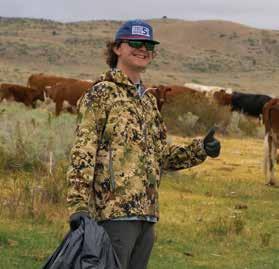
Each of these students will take the powerful lessons they learned back to their own flyfishing clubs where they will continue to build a generation of conservation focused anglers. Anglers that will invigorate the TU mission with exciting events, fresh ideas and contagious energy.
Thanks to Trout Unlimited, Costa Sunglasses and the 5 Rivers program, there are currently 3,000 active students and 17,000 alumni nationwide who carry the TU mission with them every day. Without these young voices advocating for our coldwater resources, we risk losing what we love so deeply. With the support of these young voices, we can usher in a new age of coldwater conservation that protects native and wild trout and salmon for decades.
5 Rivers is part of the Headwaters Youth Program of Trout Unlimited. To support Headwaters and the 5 Rivers program, scan the QR Code to donate. To learn more about Headwaters or 5 Rivers, contact: clifford.watson@tu.org.

—Cliff Watson





While following the disposition meetings and discussions of the Consumers Energy hydro-electric facilities on the Au Sable River, a wildcard scenario has come to light—the possible sale of the facility assets to another owner. Many believe this is the worst possible outcome from this process.
Thomas A. Buhr, in his recent book, The Big Water, recounted in vivid detail the taming of the Au Sable River’s rapid flow for use as a source of hydro-electric power. After sensing the end of the lumbering era, Edward Loud, following in the footsteps of his famous father, Henry, joined forces with William A. Foote, combining real estate acquisition and technical knowledge to foster the creation of six hydroelectric dams on the Au Sable River. Loud and Foote enlisted the enormous funding required to
construct the dams from several financiers, including Andrew Cooke, Anton Hodenpyle, Henry Walbridge and John C. Weadock. This was an enlightened group (after which many dams and powerhouses are named) who would eventually organize the Consumer’s Power Company and change the course of the Au Sable River forever.
The result of their work was a system of well-engineered and sturdily built dams that provides electric power via 150 miles of uniquely developed 140,000volt transmission lines reaching from the Au Sable Valley to Oscoda, Midland, Bay City, Saginaw and Flint. The power produced was instrumental to the development of industry in these areas. At the time, the entire project was an engineering marvel. Consumers Power, now called Consumers Energy,has gener-
ally been a good steward in that it has safely maintained their hydro facilities and contributed to riverine conservation projects. Conversely, Consumer’s Energy and its stockholders have reaped the benefits from these facilities since 1912 and controlled the future and fortune of the Au Sable River.
As historically significant as these dams and hydro facilities are, another monumental era is coming to an end in the Au Sable Valley. Consumers Energy has indicated that these facilities are no longer profitable and that, moving forward, they will require significant maintenance funding. It is, therefore, not a surprise that CE is seriously looking at the disposition of these facilities, almost 10 years before the termination of the existing Federal Energy Regulatory Commission licensing agreement. CE
is taking under consideration three options—the continuation of the operations, the removal of the facilities and the sale of the facilities to another qualified owner/operator.
It is almost inconceivable that Consumers Energy will continue the operation of their dams, having a total output of 50 megawatts of sellable power, balanced against costs they have estimated at $1.5 billion to maintain operations through another licensing period. With the first option likely to be off the table, the disposition process is really coming down to a decision to either remove the dams or sell the hydro facilities to another owner/operator.
Although the dam removal process would be an arduous task spanning decades to complete, the results would be spectacular for the Au Sable River and its communities. This effort would provide tremendous goodwill for Consumers Energy, completing the circle of prosperity they created. A free flowing Au Sable River system would be a wonder we can now only dream about and it would have the support and assistance of the conservation community.
The last option Consumers Energy is considering is the sale of its hydroelectric facilities to another owner/ operator with CE buying the power back via a Power Purchase Agreement as an enticement to support the new owners. In the opinion of many, the sale of the dams is truly the worstcase scenario for their disposition, and here is a brief explanation of the red flags associated with it. CE is a publicly regulated utility that can seek cost-recovery for capital improvements through the Michigan Public Service Commission for increases in power rates. Therefore, there has always been an incentive for CE to make necessary dam safety improvements knowing that they will be reimbursed for these costs. However, this cost-recovery mechanism for capital investments will no longer be an option under the CE proposed terms of sale. Under the terms of the proposed sale, CE will sell all its
The recent disaster caused by the failure of the Edenville and Sanford Dams are a textbook example of what can happen when a private dam is sold and should give pause to the sale of any older hydroelectric facilities through a Power Purchase Agreement.
assets associated with the hydro facilities including land and physical infrastructure in exchange for a long-term Power Purchase Agreements between itself and the new owner. Under such an arrangement the new owner will not be able to seek cost-recovery by passing on the costs of any capital investments for dam safety as they arise.
The new owner will no longer be considered a publicly regulated utility by nature of its PPA with CE. The new owner then is simply a private energy producer selling the power back to CE. This situation is a major red flag as the new owner will have no incentive to make long-term investments in the dams; rather, any capital outlays would be disincentives cutting into the revenue stream the new owners gets from CE through the PPA.
The recent disaster caused by the failure of the Edenville and Sanford Dams are a textbook example of what can happen when a private dam is sold
Continued on next page

Continued from previous page and should give pause to the sale of any older hydroelectric facilities through a Power Purchase Agreement. Boyce Hydro Power LLC bought the Sanford and Edenville dams as well as two others in the area as a tax shelter in 2006 and was later ordered, as were previous owners, by FERC to build new spillways to prevent the possibility of a dam failure in the event of a heavy rainstorm. Boyce Hydro Power claimed that they could not afford to make the needed improvements and their license to generate power was finally revoked after 12 years of haggling with the FERC in 2018. The regulation of the dam then reverted to the state of Michigan. In the meantime, no one made the needed improvements to the dam and, during an epic rainstorm in May of 2020, the Edenville Dam failed due to liquefaction. It also caused the failure of the downstream Sanford Dam and resulted in $200,000,000 in flood damages plus hundreds of millions more to reconstruct the dams. The rebuilding process and court litigation will continue for another decade.
What is the lesson to be learned
from the Edenville and Sanford Dam failures? Briefly, it is that there are a lot of older dams, such as those owned by Consumers Energy, that have outlived their usefulness as power providers. The costs for major upgrades to these facilities cannot be met even if the new owners may have good intentions, resulting in the probability of bankruptcy and ultimate dam failure. Could this scenario happen to the Consumers Energy dams? It is not likely if CE owns and maintains the dams, but what happens if they sell them or give them to an unsuspecting community unprepared to handle the long-term cost.
Isn’t an orderly removal of the dams a better scenario than wondering what might happen? Isn’t a free-flowing river a better option than neglected facilities, poor operation, raging torrents, loss of life and property and decades of litigation?
This is how that scenario might look. A new owner is deemed qualified to take over the dam operations by CE and FERC and can rely on CE to buy the generated power. What appears to be a win-win situation for the seller, the buyer and the status quo of the dam
operations has some serious risk! What if the new owner is just using the dam to “mine” its last bit of usefulness as a portfolio enhancement? What happens 10 to 15 years from now when environmental conditions, dam safety issues or regulatory changes force major updates and renovations beyond the capacity of that owner and they cannot seek recovery of those costs through rate hikes? Is CE going to buy power at a rate equal to the $1.5 billion they have estimated it would have to spend to continue operations through the next contract cycle? Probably not and the rate payers should be alarmed if they do. The answer is that the new owner will extract as much revenue as it can before declaring bankruptcy and walk away from the facility. Doesn’t this sound remarkably like the Edenville failure and could history repeat itself before the federal and state regulators act?

There are so many negative factors and risks associated with the sale of the CE hydro facilities to a private owner that it is hard to wrap your arms around the possibility! Isn’t an orderly removal of the dams a better scenario than wondering what might happen? Isn’t a free-flowing river a better option than neglected facilities, poor operation, raging torrents, loss of life and property and decades of litigation? Ultimately, there are multitudes of serious questions to be answered if the dams are sold. Who will be responsible for the end game removal of the dams? Will the new owners be good stewards of the river? Will the new owners be forced to meet the requirements of the Clean Water Act? Real concerns and many others with no answers as of now.
It will be interesting to see if Consumers Energy chooses to exit their responsibilities and liabilities by selling the facilities, taking the easy way out, instead of being the better steward of the resource they have used for over 110 years. Who would be better than CE to continue operations, gradually removing the dams and disposing of the vast real estate holdings they possess? The fact that CE is exploring the sale of the dams, whether as due diligence or a diversion tactic, does not ethically relieve them as the most suitable organization to remove or continue operation of the dams. Sale of the Consumers Energy hydro facilities via a PPA would be a classic example of corporate and regulatory agency short sightedness, and certainly the worstcase scenario for the disposition of the dams and the future of a free flowing Au Sable River system, as it once was. Isn’t it about time that we make rivers the priority? Isn’t it about time to safely give them back to nature and to the people that enjoy and them? Time will tell…. stay vigilant.
—Robb Smith, reprinted courtesy of Michigan TU








































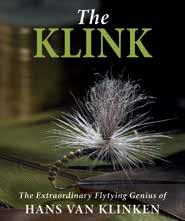

TROUT magazine’s editorial family was deeply shocked and saddened by the sudden passing of John Gierach, whose columns (in partnership with artist Bob White) have anchored the feature well of TROUT for the past 29 issues (7½ years). There are more stories yet to be printed, including in this issue, and we are planning an appropriate tribute for the spring edition.
“Things won’t be the same without John, but I count my blessings that I was able to work with him, fish with him and consider him a friend,” said TROUT editor Kirk Deeter.
Our heartfelt condolences go out to John’s wife, Susan, as well as his many friends and admirers.
Hardy special edition “Tealweight” reels are here… and they’re awesome.
Hardy has produced a limited edition of special “TU Tealweight” reels at its headquarters in Alnwick England, specifically to honor TU’s 65th year of existence and support the organization’s work that connects and restores small streams throughout the United States. It’s a click-pawl that will best accommodate 3or 4-weight lines, and it is hand-built. There were only 300 made, each numbered, and TU has 100 of them to support our current Griffith’s Circle campaign. The other 200 will be sold by select fly shops throughout the world.



The Klink: The Extraordinary Flytying Genius of Hans Van Klinken
By Hans Van Klinken; Foreword John Roberts Merlin Unwin, merlinunwin.co.uk, $65
One of the best tricks in fly fishing is taking fly patterns developed in different parts of the world and applying them on your home river. And one of the best attractor fly patterns for any home river is arguably the Klinkhamer (or simply the Klink), a genius do-all concoction that can be shaped, sized and colored to appeal to trout in myriad ways. This is the brainchild of one of Europe’s most noted fly innovators, Hans Van Klinken, and this book is a backstory, not only this famous fly and others, but also on the man, who was born in Eindhoven in The Netherlands, served a career as a commander of the Royal Dutch Army Gunnery School, yet also managed to shape the future of fishing through his adventures on the most legendary rivers in Europe. It’s interesting and refreshing read, offering valuable context and perspective. —Kirk Deeter
By Richard K. Lodge Plaidswede Publishing, plaidswede.com, $20)
Another book that pays homage to a master fly tier, is The Rise of the Neversinker: Fly Tier Rube Cross by Richard Lodge. Though he sadly died in obscurity and poverty 70 years ago, Reuben R. Cross became known for tying the most beautifully crafted patterns associated with the Catskill region. This is a story as much or more about how Rube tied, as it is about what he tied. This entertaining narrative offers a fresh glimpse on the Catskill School, and Catskill flies—no easy feat given the volumes already published on these hallowed subjects. This is a niche book, for sure, but it’s a breeze read, well researched with some interesting nugget on every page. And it will resonate with those who appreciate the craft of tying flies. —KD


By Steve Duda Mountaineers Books, mountaineers.org, $25
Steve Duda is the former editor of the Flyfish Journal, and is now Head of Fish Tales at Patagonia, guiding the brand’s flyfishing activism and storytelling through film, video, web, social media and more. He’s also an accomplished musician and a heck of an angler. So, having known him for years, I knew when he did pop out a book on fishing tales, it would not only be good—his words are often lyrical—it would also be honest. There’s a ton of been there done that substance behind Steve’s writing, and almost no pretentious been there done that man conquers nature baloney that often ruins good writing. I mean, who else describes a fresh-caught barracuda as smelling like cucumbers, perhaps with a splash of lemon? And if you’ve ever caught a barracuda, what does it smell like? Exactly. Duda is an observer, the best kind of writer who knows he was born with two eyes and two ears and one mouth with good reason. When he does mouth the words, they always matter. Technically, and entertainingly, this is other level writing. —KD
By Sage Marshall Middle Creek Publishing, middlecreekpublishing.com, $18
Sage Marshall’s debut book of poems, Echolocation, is rife with honesty about a tough and gritty world. Hailing from southwest Colorado, Marshall is currently based

in western Montana and is a freelance journalist and contributing writer for Field & Stream. As a hunter and angler, his writing is steeped in experience of the outdoors. From first lessons learning to fish with nightcrawlers as he describes “boyhood collected in the tobacco tin,” to dreaming “of indicators sinking quick” and returning to the same pool morning after morning, “as through answers / could be knotted / to the end of the line,” Marshall writes about the natural world, finding oneself, and family, with sincerity and self-reflection. These are poems acutely aware of both the beauty we inherit of the world and the pain we inflict on ourselves and others. I highly recommend picking yourself up a copy. —Erin Block
By Steve Ramirez Lyons Press, globepequote.com $32.95
We’ve followed Steve’s “Casting” series of books from the beginning. Casting Onward is rooted in the Texas Hill Country; Casting Forward took him in search of native fish with various companions; Casting Seaward was where he ventured into the salt; and now with Casting Homeward, he searches out iconic landscapes and both angler and
naturalist. Ramirez has always done a good job of conveying that fishing is really about more than the fish, namely, it’s about places and the people you share them with. In this book, he literally brings that notion “home” with great effect. It’s easy to appreciate the places and characters described in this book, and even easier to appreciate Steve’s downhome writing style. If you’ve enjoyed any or all of the previous books, you need this one to complete the cycle, and the journey. —KD


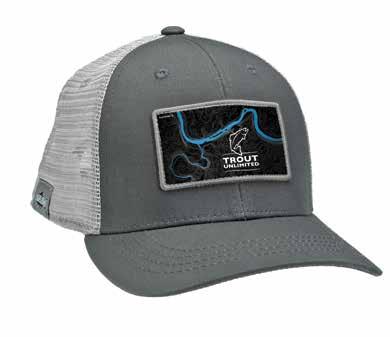
As you consider getting geared up for the year ahead, here are five products that the editors of Flylab (including TROUT editor Kirk Deeter) spent a lot of time testing over the past year, which climbed to the top of the recommendation list. For more straight-shot product reviews (more than 80 so far) check out flylab.fish. It’s free.
Ross Animas reel
$385: rossreels.com
Who will appreciate this reel most? The practical angler who wants function and performance, but doesn’t want to break the bank or make an artistic statement with a reel. Granted, you can be upsold on Animas models that carry unique designs and benefit certain causes, but you can decide if the extra money is worth it.
This is the kind of reel that can play any role in your gear roster. It’s your primary trout reel. It’s a backup to the slicker reel you paid more for. It’s the reel you give as a present to your daughter or son—the reel to last a lifetime. It’s the reel you buy for yourself because you just got a new rod and don’t want to swap reels back and forth. It’s the reel that, if you’ve been saving up to get a “classic” with a discdrag, you can feel good about making a smart choice. You can hang it on any rod, and it will never be outclassed, nor will it be an overstatement.

“All you really need” is often overused, and yet also underappreciated. But in this case, it’s a deserved, appropriate compliment. “All you really want” is, of course, an entirely different ballgame. For the angler who is able to reconcile both, the Animas is hard to beat. —Kirk Deeter

$299: patagonia.com
Who will like it? Anglers looking for a lightweight, fully submersible and minimal backpack that won’t break the bank. A versatile p ack that’s great for bushwhacking, but also travel. You may miss the old, exterior pocket for your keys and phone, but there’s a lot to like with Patagonia Guidewater Backpack: comfort, lightweight, clean design and price. If you’re thinking about lugging important equipment in wet, rainy environments, it’s important to have some water-impervious peace of mind when you’re out and about. Patagonia is also a highly accountable brand, putting their money where their mouth is in terms of sustainability and awareness for the environment. This may not contribute to the overall quality of the pack, but it’s good to know consumers can do their small part in helping move the sustainability needle. —Will Koenig


$150: korkers.com
If you appreciate product value, if you’re focused on foot comfort as you fish, if you’re a “sneaker head” who actually cares about footwear styling, this shoe/ boot is for you. If you’re a weekend warrior, who likes to dabble into the backcountry, this boot/shoe is for you. If you row a boat all the time, and don’t want goat stompers on your feet every day, these are a good option too.
If, on the other hand, you need guide-level durability, or you require incredibly stiff soles to keep you stable as you wade—not so much. But kudos to Korkers for a good idea, thoughtful design and making some waves in the wading boot world. The sticker price is also pretty reasonable. —Tim Romano
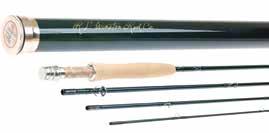
$995: winstonrods.com
If you like Winston rods, you’ll like this one. If you liked PURE, you’ll like PURE 2 more, and you’ll feel a difference, starting with the slightly larger grip. The PURE 2 is a more advanced fly rod and a pleasure to fish. I would gravitate toward the 8-foot-3-inch length, especially in the 4 weight. After all, it’s not a Euro nymphing rod—it was specifically designed for fishing dry flies.
Some of my good friends might suggest the rod is a little tippy, but I think you’d maybe only notice that if you wanted to make bomber casts on wide open western rivers. One ironic thought I’ve had after fishing the 8-foot 3-inch 4-weight on the Henry’s Fork in Idaho—Winston, long proud of its Twin Bridges, Montana, roots and considered an icon of Western fly fishing, may very well have created in Pure 2 the quintessential dry fly rod for Wisconsin’s Driftless region, northern Michigan, the Catskills and Appalachia. —KD

$59: cheekyfishing.com

You want a backup fly line for your 5-weight, because you’re going on a trip, and need a spare? But you don’t want to break the bank? This is your line. You want a line for your 3-weight that you fish only two times a year, and you don’t want to shell out a hundred bucks. This also works. You’re new to fly fishing, are blown away by how expensive everything has become, and just want a line that gets you in the game. No problem. The All-Day Freshwater Fly Line translates in all these scenarios (and others). Nothing flashy. No breakthrough technology. Just a line that casts smoothly and performs without the high-end price point. And nobody notices the line you fish other than yourself. Of all the fly-fishing products, the fly line plays to an audience of one, more than anything else. If you’re feeling it as you cast, that’s all that matters. Fly fishing needs more stuff like this. —KD

Our great poets expressed this longing most eloquently, complex creatures like Whitman and Dickinson, seeking the ordinary. Simplicity, wrote Mary Oliver, is freedom.
“I felt like the little donkey when his burden is finally lifted. Things! Burn them, burn them! Make a beautiful fire! More room in your heart for love, for the trees! For the birds who own nothing – the reason they can fly.”
Picture a family on a river, the family unit united with other contingents of like mind into a posse. A river trip. Away, down a red-orange canyon, beyond technology, cell phones useful only as cameras, recorders of this unfettered life of moving as a river moves. Propulsion is muscle and gravity, the home—from kitchen to weather shelter—carried in a craft 16 feet in length.
The river is no longer a trout river. Upstream, yes. It is born in the high southern Rockies in the snowmelt of 14,000-foot peaks but this is a warm desert waterway now, a carving, cutting river that carries nearly as much grit as it does water. It grinds more surely than mano upon metate and the bones of those great mountains are powdered into the sands of its beaches.
It is upon one of these beaches that the tribe stops and lounges for a time, the adults resting back on elbows, just living in the moment. The children, their coveted technology of screens long forgotten, muddy and bloody and bruised. But happy. Laughter is everywhere, in current over stone, in the relating-to of adults, in the play of the children.
One of these is a boy of six, his palindromic name comprised of only the letters O and T. Otto lies face down on his raft, peering patiently into the
turgid water. The other children are skipping rocks and rolling cartwheels, but he pays no attention to them. This is serious business. He is fishing. In his hand is a willow pole. A day ago and miles upriver, the fishing reel—complexity—succumbed to the tireless sand and quit, but no matter, a willow switch will do. Add a little fishing line, a hook and a piece of pepperoni that the parents had intended for pizza night. And here is a fish, a catfish. The adults laugh and pull out phones-turned-camera to take pictures of a boy on his belly on a raft in a desert river holding up a 12-inch fish plucked from warm water because it liked the smell of Italian meat. The adults go back to their inside baseball humor and the boy to his fishing. “I got another one,” he cries and indeed here is another catfish. Then another and
It is good and right to stop every once in a while and channel the boy and the willow pole. To think about the river and its fish and to work through the puzzle that is fooling that fish with your offering. To see a water from a child’s level free of voices in the head, to simplify.
another. Five catfish in all. At length, the herd gathers, packs up, launches back to the river’s shoulders, down around a bend or two to the next camp, the whole lot experiencing life at its most basic level. We age, change, grow, complicate intentionally and unintentionally. We take this convolution everywhere with us, into our workplaces and our homelife and into our sport. Astride this galloping steed that rules our lives is the passenger known as elitism. Those who cannot understand and at the same time
outright dismiss, even deride, those who may see or do things another way. Why are you going to vote for that politician? It cannot be simply that you like him. If I cannot grind you down with my logic as surely as a sand-laden desert river grinds a canyon of stone, then you must be a fool. Why are you bait fishing? Fishing with treble hooks? Eating your catch? Can you not see that you are doing it all wrong and there is only one right way?
The same precept applies to our needless and endless love of gadgetry. An angler wearing one type of material—say rubber hip boots—is openly mocked by those adorned in the latest high-tech waterproofery. A beaten-up old aluminum boat is no way to float a river. A fiberglass rod instead of graphite? A one-handed rod instead of Spey? Are you a rube? Tens of thousands of different fly patterns must surely be better than a handful, yet the venerated fly fisherman Yvon Chouinard easily disproved this maxim by fishing only one fly pattern for an entire year on everything from salt water to fresh, and catching scores of all types of fish, from bonefish to salmon to trout. Simple does work and sometimes it works better. Far better.
It is good and right to stop every once in a while and channel the boy and the willow pole. To think about the river and its fish and to work through the puzzle that is fooling that fish with your offering. To see a water from a child’s level free of voices in the head, to simplify. Because sometimes the answer really is the easy one and there is no question at all.
Thomas Reed does his dead-level best to live the simple life on his family’s ranch outside Pony, Montana. He is the author of several books and has spent his life in the West in pursuit of fish and game and truth. His latest work is as an editor of Mouthful of Feathers, Upland in the West, an anthology of hunting and dog stories.

BY THOMAS REED


I don’t start tying flies right after Thanksgiving every year, but that’s when I start thinking about it. Fishing isn’t really over by then (the season never closes here in Colorado) but by late November catching trout has gone from a daily possibility to an outside chance and no longer beckons so seductively. It’s true that I once did my share of mid-winter frostbite fishing, believing anything in sport that could be done should be done, but more recently I’ve decided that there’s a time to go fishing and a time to come in out of the cold to regroup for another season.
Does that mean I’ve had enough? No fisherman would ever publicly admit to getting in enough fishing, but I’ll confess that by the time I sit down to Thanksgiving dinner with friends, I’m happy to discuss grown-up topics with people who don’t fish and when someone politely asks how my season went, I’ll say it was “fine” and leave it at that, even if I have to bite my tongue to keep the whole long story from tumbling out.
I could start tying right away (and may come to wish I had) but I’ll put it off. I tell myself there are more pressing wintertime chores to take care of, a livelihood to maintain and a personal life to look after—all true enough—but also because spring fishing seems so improbably remote it’s hard to even imagine, let alone prepare for. Think of it as fly tier’s block: that state of mind that makes me want to write about tying flies instead of actually tying flies.
I learned to tie in an attempt to save money back when I was working for the minimum
wage of less than two dollars an hour and although you could still get a small draft beer for a dime at my local bar, a well-tied trout fly could set you back as much as 50 cents. Anyway, that was the plan, but it would take a forensic accountant to work out if I saved, lost or broke even in the intervening years as well as a panel of psychiatrists to unravel whether or not I even care.
Lashing fur and feathers to a hook doesn’t sound that hard until you try it and learning the new skill cost me more in time and head-scratching than I anticipated. The sketchy instructional books of the time weren’t as helpful as I’d hoped and led to the usual quotient of heartbreak and second thoughts, but I stayed with it and saw just enough progress to keep a beginner going. It
Sidewinder no-hackles, Ken Iwamasa’s burned-wing Duns, Roy Palm’s buggy Biot Emergers or any of the countless other patterns that arose at a time when new blood was entering the stodgy old sport and innovation was steamrolling tradition. One day you could change the wing material or body color on an established pattern and be told that you’d tied it wrong; the next day you could do the same thing and get credit for inventing a new pattern. All through the 1970s and ‘80s and beyond, it seemed like every fly tier not only had a better idea, but half of them had published a book about it. Friends were forever showing up with new fly patterns they’d either read about somewhere or dreamed up on their own and named after themselves in a bid for a little low-rent immortality.
The way I saw it, dabblers, dilettantes and the idle rich bought their flies over the counter, while serious and self-reliant fly fishers tied their own, and like all novices, I wanted to be one of the cool kids.
helped that I was committed. The way I saw it, dabblers, dilettantes and the idle rich bought their flies over the counter, while serious and self-reliant fly fishers tied their own, and like all novices, I wanted to be one of the cool kids. The inflection point must have come the day I caught my first trout on a fly I’d tied myself: a moment I’d worked toward and probably thought I’d never forget, but have since forgotten.
At first, I thought if I could learn to tie a few basic patterns—say, Adams and Elk Hair Caddis dry flies and Hare’s Ear Nymphs in four or five sizes—that’s all I’d ever need. And I might have been right if I’d stuck to the freestone mountain creeks in my own neighborhood, but soon enough I found myself on spring creeks and tailwaters where trout would turn up their pretty noses at those old standbys, but would sometimes tumble for A.K. Best’s elegant quill-bodied parachutes, Rene Harrop’s minimalist
I toyed with innovation myself, but nothing much ever came of it. I adopted Ed Schroeder’s versatile Hare’s Ear Parachute dry fly and over the first few seasons of fishing it I changed the wing material, the rib color, the tailing material and the hook it was tied on, but I was only marking my territory and didn’t have the chutzpa to claim the fly as my own. And I tie a Hare’s Ear Soft Hackle with bead chain eyes that’s become my go-to dropper on freestone creeks, but it’s such an obvious variation on existing themes that I can’t believe dozens of other tiers haven’t had the same brainstorm. The fact is that genuinely good new ideas do pop up from time to time, but most trout flies are like folksongs that everyone interprets as they see fit, but that should rightfully be attributed as “traditional,” even though some don’t want to hear that. (I once seriously pissed off a bluegrass fan during a local music festival by saying there are only two kinds
of bluegrass song: a fast one and a slow one and the guy murders his girlfriend in both of them.)
Anyway, I read the new books, bought the new hooks and materials, learned the new patterns and techniques, bought more fly boxes to store all the new flies in and then bought a new vest with more pockets to carry all the new boxes. I wasn’t one of the great fly tiers and never would be, but I had it bad for a while and if fly tying had been a motorcycle, I’d have had to see how fast it would go.
I even flirted with turning pro in a part-time way by taking on a few orders for large numbers of Elk Hair Caddises, a cheap fly to tie and fairly simple once you got the hang of it. If nothing else, it was good practice. One mark of a topnotch tier is uniformity: If you dump a dozen of his flies of the same pattern and size on the desk, one will be nearly indistinguishable from the next. Most of the tiers I know eyeball their proportions against the shank and gap of the hook and after enough repetitions that becomes second nature. But tying flies I’d never get to fish was a prescription for drudgery and although I was still young, I already knew what it felt like to ruin something fine by trying to squeeze money out of it, so when the next order came in, I turned it down.
Things lurched forward and time passed, as it does. When the dust settled, I’d become an adequate tier, gotten something out of my system—although I can’t say exactly what—watched my fly selection become grotesquely bloated and then shrink back in the general direction of simplicity until I traded the bulging vest that a woman I knew described as “unflattering” for a small sling bag. It was nothing systematic, just a general tendency toward simpler flies and fewer of them. I think I’d finally realized that the sheer number of fly patterns in existence—thousands that are documented, plus countless others that came and went without notice—only proved that a trout will bite anything under the right circumstances and that flies are like money in the bank: you can aspire to the kind of ponderous wealth
you’ll never achieve or you can learn to live comfortably within your means.
We Americans approach most tasks, including that of catching fish, with an “Insert tab A into slot B” mentality as if there were only one right way to do it. But experience suggests that if you have a working knowledge of the ecology and hydrology of rivers, a basic understanding of trout habitat and behavior, are able to manage good daily and seasonal timing and can cast reasonably well, you can usually catch your fair share of trout with a modest, but well-rounded selection of flies. (If you’re one of those who wants to catch more than your fair share, I have no advice that you’d find useful.)
I can still see archeological evidence of those past years in my fly boxes. In the deepest strata are a few sentimental favorites that could have been in the box I carried the year I took up fly fishing and that now give me the feeling we sometimes get later in life that I was right in the first place, but then wandered off on a long, pointless detour. I like to think that I’ve always been open to new ideas, but at the same time, I’d more or less settled on all the important stuff by the time I was 20, including, but not limited to, the Adams, the Hare’s Ear and a general philosophy of liberalism with a lower case “L.” Another inflection point was the first time a young fly fisher looked over my shoulder into one of my boxes and said, “Dude, that’s old-school.”
There’s no telling how many other patterns I tried and either rejected outright or just drifted away from. Some turned out to be unnecessary or repetitive, others were too complicated, too delicate and/or too time-consuming to tie, like the extended-body mayflies that were all the rage for a while and that come back into style periodically. Still others were local favorites on rivers I fished once and never went back to or the regional oddities that have become rare now that fewer flies are tied locally. And some were simply the results of commercialism: flies that came with a plausible sales pitch, but amounted to solutions to nonexistent problems and were designed to catch more fishermen
I think I’d finally realized that the sheer number of fly patterns in existence—thousands that are documented, plus countless others that came and went without notice—only proved that a trout will bite anything under the right circumstances and that flies are like money in the bank: you can aspire to the kind of ponderous wealth you’ll never achieve or you can learn to live comfortably within your means.

than fish. All I know is that I tied them all for reasons that seemed practical at the time, but that in retrospect may have had more to do with fashion or novelty than I thought. How else can I explain my brief infatuation with a pattern known as the Pink No-ass?
I now feel reasonably confident that if I can match the size and behavior of the flies the trout are eating, nine times out of 10 I’ll probably do okay, and on those inevitable days when one fly and one fly only will catch fish, I’m happy to write it off to the inexplicable nature of fishing and try to buy or borrow one of those flies. But I also hedge my bets to the extent that my Green Drakes are green, my Pale Morning Duns are appropriately pale and my Blue-wing Olives aren’t just olive, but a precise shade of olive achieved by blending five colors of dyed rabbit fur together in strict proportions as per the recipe in A.K. Best’s 1993 book Tying and Bleaching Natural Fly-Tying Materials. (Arguably, that and Ted Leeson and Jim Schollmeyer’s massive, Fly Tier’s Benchside Reference, are the only two books a tier would ever really need.)
I’m
thinking of patterns like Dave Whitlock’s classic Dave’s Hopper. Tied right, it’s startling how much this impressionistic fly looks like a real grasshopper, but I have trouble getting the knotted legs to sit at the right angle, so mine often look more like a dog pissing on a tree.

Dave’s Hopper
and as a capitalist, I understand that if I want either to be there the next time I need one, I’m obliged to spend some money there in my own best interest as well as theirs. But then when I graze through my hero shots—the snapshots thumbtacked to my office wall of the biggest and prettiest fish I’ve caught—I can’t remember what fly any of them were hooked on. The best I can do is make a wild guess based on the place, the apparent time of year and how young or old I look in the photo.
had lasted for most of the winter—not to mention the knowledge that before muscle memory kicks in and it all starts to feel familiar again, the first few flies will be clunkers and I’ll wonder when it was that my eyesight went south and my fingers stopped working. Tying flies really is like riding a bike, but when I haven’t done it in five or six months, I’m still likely to wobble a little for the first few blocks.
Eventually, the sense of self-reliance I got from tying my own flies evolved into the unfounded belief that—for certain patterns at least—the way I tie them is how they should be tied and I’ll accept no substitutes. On the other hand, I’ll happily buy flies I’m capable of tying, but that are so difficult for me that I can’t be properly reckless with the ones I make myself. I’m thinking of patterns like Dave Whitlock’s classic Dave’s Hopper. Tied right, it’s startling how much this impressionistic fly looks like a real grasshopper, but I have trouble getting the knotted legs to sit at the right angle, so mine often look more like a dog pissing on a tree. And if I travel to some river and find that the hot fly that week is a pattern I’ve never seen or even heard of, I’m not too proud to buy a handful at the local fly shop. In fact, I’m happy to do it. I love fly shops the way I once loved dive bars
I’m not sure what finally gets me tying every year. Once it was the annual ritual of going down to the hardware store in the week between Christmas and New Year’s Day to buy my new fishing license. Something about that small official document wisely printed on waterproof paper would set me off on a project of checking lines, patching waders, replacing leaders, oiling reels and eventually tying flies. But they’ve since changed things so that the old license doesn’t expire until April, which is too late to start tying. So now it has to be something about the weather or the length and quality of daylight; the kind of seasonal trigger that would stir a dim urge in the mind of a migratory bird. Or maybe it’s a friend who asks, “You been doin’ any tying?” I know what he’s up to. He hasn’t been tying, either, and he’s hoping I’ll jump-start him by saying something like, “Yeah, I’ve been at it for weeks.”
So there’s this inertia that has to be overcome—as if the postprandial drowsiness that set in after Thanksgiving dinner
It’s hard to describe how I’ve come to feel about the job of tying flies except to say that I do consider it a job of sorts—as in a means to an end—although I can’t argue with those who think it’s an art form in its own right. If nothing else, I’ve never found a definition of art that I completely agreed with, although the novelist Richard Russo came closest when he said that maybe art is nothing more than “solid craft with a dash of style.”
Usually I tie flies more or less on auto pilot—while thinking of something else or listening to the radio. Sometimes I’ll still catch myself smiling at being able to do this small but useful thing that once made me sweat with frustration, and other times I enjoy tying the way my father enjoyed paying bills. It’s not that he was thrilled about parting with his hard-earned money, but he did like being consequential enough in the world to incur bills in the first place and solvent enough to pay them when they came due. It was all part of what his generation would have called, without irony, “a man’s work.”
I try to make the best flies I’m capable of, but my goal as a tier is no longer perfection—if it ever was. Once I decide how a pattern should be—its proportions, color, texture and sense of either elegance
or folk-art funkiness—I want them all to be that same way, but I recognize that they’re expendable: Like money, food or firewood, flies are useless until you use them up.
If I’ve been vague in places here it’s because I find that I can’t summon anything like a coherent narrative of my nearly 50 years as an amateur fly tier. Janet Malcom was right when she said, “Most of what happens to us goes unremembered,” and it’s also possible to remember things that didn’t actually happen, like the incisive wise crack that would have won that argument back in the mid-‘90s if you’d only thought of
it at the time. Eventually actual facts run together with daydreams, wishful thinking and the irresistible urge to get your story straight until remembering becomes the kind of docudrama that’s based only loosely on actual events.
But plenty of other verifiably memorable things happened in that same nearly half century. Politicians came and went— catastrophically and otherwise—along with natural and man-made disasters. Wars started and were resolved somehow without ever entirely ending for those who fought them or those who waited at home. The climate change we’d been warned about for decades arrived—slowly
and imperceptibly at first and then like a house afire. Loves, jobs, homes and friendships were gained, lost, forgotten or just wore themselves out. Some of the people in my life moved away, died or otherwise left in all the ways people do while I got older day by day, all against the usual American backdrop of public buffoonery, senseless mayhem and odd moments of perfection. And almost as an afterthought, I tied some flies and caught some fish, something most would consider—if they considered it at all—to be nothing more than a quaint and harmless hobby.

I love fly shops the way I once loved dive bars and as a capitalist, I understand that if I want either to be there the next time I need one, I’m obliged to spend some money there in my own best interest as well as theirs.
F I S H I N G
F L O S S E R S A M O N G
BY KRIS MILLGATE
Bones is in the driver’s seat. She’s yawning. Kenai Fly Fish owner Ian McDonald stands behind Bones. He’s steering. My husband and I met the pair on a boat ramp at sunrise. Bones looks like a smaller version of a German shepherd, but coated in pale hair the color of puffy clouds in June. In contrast, McDonald’s waders are rainstorm dark, but his demeanor is as friendly as fall leaves piled for a plunge.

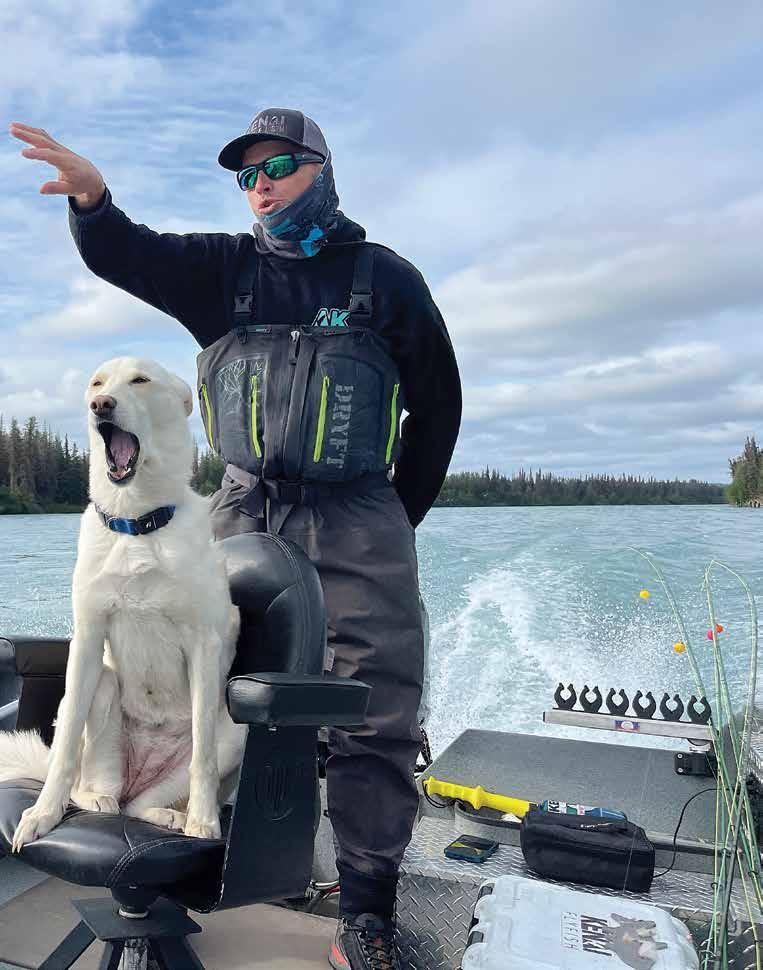
When I called a few months back to book the day, he suggested the Upper Kenai River because we fly fish and the Upper is the classic opportunity with mountain scenery, drift boats and setting hooks on salmon. I was intrigued at first. I’ve never caught a salmon in my home state of Idaho. Catching one in Alaska would be fantastic. Then the Chinook season closed on the Kenai just like it does in Idaho and for the same reason. Lack of fish. Kenai’s King salmon turned into a stock of concern in
the summer of 2024, prohibiting sport fishing, including catch and release. When the Chinook run tanked, the Upper Kenai lost its appeal for me. Without Chinook to target, we’d be going all the way to Alaska to fish out of a boat type, drift, that we already own for the same fish species, trout, that we already catch five minutes from our house. We’d been to Alaska before, for our honeymoon, but this would be our first time fishing Alaska. It’s a return trip for our 25th wedding anniversary. If we’re traveling all the way to Alaska’s
Kenai Peninsula, I want something different to justify the distance. McDonald is putting us on something different. We’re going for rainbows that are fatter than footballs, but not in the setting I’m used to. We’re on the Lower Kenai, a stretch of combat fishing that’s in frenzy mode during a salmon run and we are here during a run. Sockeye are coming through.
“There will be 50 fishers shoulder to shoulder,” McDonald hollers over the engine propelling us downstream. “But that’s half of what is usually here.

The South Fork is gin clear nudging toward the color of green glass. The Kenai, more like the best blue marble in the bag. It’s the same color as the receding glacier we hiked to yesterday.


The South Fork is gin clear nudging toward the The run is winding down. Another week there will be nobody.”
I’m staring down at the water as we motor. It’s impossible not to stare at it. The Kenai River is wide, mostly flat and feels similar in size to my home water, Idaho’s South Fork of the Snake River. The South Fork runs about 18,000 cubic feet per second (cfs) in the spring. So does the Kenai, but their similarities end there.
The South Fork is gin clear nudging toward the color of green glass. The Kenai, more like the best blue marble in the bag. It’s the same color as the receding glacier we hiked to yesterday. Its jagged tips were snow white, like stale cubes stuck to the interior of your freezer. But the deeper you looked, the bluer it became as if the sky was hiding between the ocean and the ice. The Kenai has the same astounding aqua glow as that glacier.
I N
I look up from the mesmerizing water when McDonald kills the engine. The cause of the abrupt stop draws my gaze to the bank where I confirm what McDonald hollered earlier. There are indeed 50 fishers shoulder to shoulder. They’re stacked sardine style between the water
line and the private property line on a weathered boardwalk tacked to the side of a dirt drop off.
The Lower Kenai is constrained by cabins on both banks with a few, slim public access alleys. Anyone can fish the public spots, but the riverfront cabin lots are private. Most are second homes for families counting on the Kenai to fill their freezers with fish. That’s who is perched on the precarious planks, families fishing with their kin while I’m thinking of mine.
There’s a mom with four boys. I have two boys. They’re not with us in Alaska, but we fish together back home. When I sent our teenagers a photo of me and their dad tucked in a tiny house on the coast last night with the message, “I miss you,” The reply was, “I miss you cooking for me.”
Smiling as I bring my wandering mind back to the boat, I see McDonald looking at me with a “Hello?” expression on his face. He’s handing me a lefty reel. I feign all in, even though I was checked out, and take the 10-foot rod with a quick thanks then hide it behind my back. It’s bad form for boaters to park on top of bankers back home, but that’s what we’re done here so I’m anxious. As we float closer to the shoulder-to-shoulder
crew, I don’t make eye contact. I look at the chutes instead.
Almost every property along the river has a chute, like those steel playground slides that burn your backside on hot days only wider and shorter. Or the white, cracked accordion tube shuttling spent heat out of the dryer in your laundry room. The chute is attached to a waist-high table. Both the chute and the table are rudimentary in design but functional in high volume. Together, with the addition of one well-practiced
“They’re used to catching one every cast. They start at 6:00 a.m. Two of four rods are done by 6:30 a.m. Their limits are made early, but it’s uncommon if they get off the water early.”
—Aaron McDonald
butcher wielding a fillet knife, they process pounds of fish. I don’t know who holds the knife, but I’m certain they’re related to everyone else.
In Alaska, I’m discovering family is as prominent as fish. The realization surprises me because I think of Alaska as the state of the lone miner, but relations are on display everywhere and I don’t think I’m exaggerating just because I miss my boys.
McDonald’s dad is one of his guides. The water taxi we took to an island was named after the tour operator’s grandma. Genetic connection is evident in wildlife too. In Kenai Fjords, a pod of 20 humpback whales work together to devour aquatic life corralled under the water while a pair of bald eagles with two juveniles nested overhead do the same thing. Feed their family.
There’s movement behind me. I look over my shoulder as Bones, a member of the McDonald clan, exits the driver’s seat to sprawl on the platform at the nose of the 20-foot boat. My married mate of 25 years is casting when I look over my other shoulder. I’m still hiding my rod.
I spy a little girl in a red lifejacket. She’s showing a handful of pebbles to her grandpa. That’s my assumption based on his speckled hair and wrinkled skin. They are family. I never fished

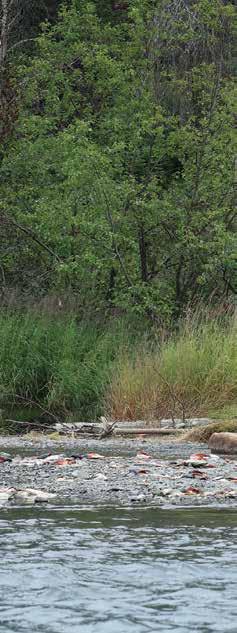
with my grandpa when he was alive, but I have his old fishing license. Sometimes it rides shotgun in the front pocket of my waders. I’m saving my old licenses for the same ritual. Maybe my grandkids will carry me with them on their trips when I’m gone.
My sentimental thoughts are interrupted when a series of plops splash in the water two feet in front of my feet. The only barrier between me and the spray is the shin-high, aluminum sidewall of McDonald’s boat. I say it’s the bankers throwing rocks at us, the boaters, because we are too close. McDonald corrects me. The plops are not rocks. They are hooks hitting
“It’s flossing, not snagging. There’s 100,000 sockeye moving at a walking pace with their mouths open. Bank casters floss their line through the fish’s mouth. It’s a technique. It’s not a snag.”
—Aaron McDonald

the water then sinking toward sockeye. The chuck and duck swing the bankers perform between 10-second drifts has to wreak havoc on their shoulders, but they are consistent. There’s a rhythm to it and a reason.
“They’re used to catching one every cast,” McDonald whispers because now we’re within earshot of the bank. “They start at 6:00 a.m. Two of four rods are done by 6:30 a.m. Their limits are made early, but it’s uncommon if they get off the water early.”
I understand why. This is their family time and as each generation learns to cast, they also learn to floss. That’s what the bankers are doing. Flossing. This is the something different I wanted.
“It’s flossing, not snagging,” McDonald continues. “There’s 100,000 sockeye moving at a walking pace with their mouths open. Bank casters floss their line through the fish’s mouth. It’s a technique. It’s not a snag.”
Sockeye swim close to shore so the flossers harvesting on the bank know a rare boat floating down the middle of the river with catch-and-release fly casters throwing line toward them are targeting rainbows, not sockeye. It’s a non-compete arrangement. That’s why bankers are okay with boaters sidling up.
We all partake of nature’s abundance. The flossers on the bank harvest sockeye. Sockeye leftovers the size of long French bread loaves are the flesh and eggs sliding
down the chutes back into the river. Rainbows are waiting for the buffet sinking to the bottom. Fly casters in boats try to bring those bows up by sneaking a beaded egg pattern into the stew we’re gathered around. It’s a family feast with fly fishers among flossers.
Outdoor journalist Kris Millgate is based in Idaho where she runs trail, chases trout and hunts birds. She followed salmon migration solo during the pandemic for the wildlife film Ocean to Idaho. Her Emmy-winning film, On Grizzly Ground, is available now along with her third book My Place Among Beasts. See her work at www.tightlinemedia.com.
The beauty of trout fishing is that it inspires hope. Plain and simple. That’s where it all starts and ends.
Think about it. Every cast you make ignites a tiny little episode of hope.
You drop that cast right near the spot where you saw a trout rise a moment before, and what’s the first thing you feel? Hope. You flick a lure behind the log where you think that big fish lives, and for a brief instant, you feel hope. With every strip of a fly line as you fish a streamer fly, what’s flashing through your mind—whether you realize it or not—is… hope. Over the course of a day on the water, that might add up to hundreds, maybe thousands of mini doses of hope.
Is it any wonder why people who are working through issues like illness, depression, addiction, isolation, PTSD and more, find solace and comfort through fishing? It’s because of those accumulated bits of hope. They matter. Hope changes lives.
Cast Hope might just be the most aptly-named, fish-related organization in the world. But there are many others that fit the bill, from Project Healing Waters to The Mayfly Project, Casting For Recovery and many, many more.
The best part is—hope is free. Anyone can make their own hope through fishing. You don’t need a fancy rod and reel. You don’t have to be an expert caster… or fly tier… or hatch-matcher to have hopes.
You don’t even have to actually catch fish for the hope factor to have effect. In fact, if you caught a fish on every cast, it wouldn’t be about hope—it would be about expectations, and how fun would that be? Of course, it’s also no fun to spend a day only hoping you don’t get hung up on the river bottom or snagged in the bushes. But without knowing disappointment, you cannot really know hope. Discard the frustration, accentuate the positive, and know that a little bit of success here and there—watching that fish inhale your fly off the surface or feeling the tug on your line—definitely primes the pump.
When you do hook up, one episode of hope replaces another—you go from “I hope that fish eats it” to “I hope I can land this one!” When it all works… well, you build a clearer picture in your mind of what you’re really hoping for. The more you fish, the stronger hope grows.
Eventually, we land at a place where we aren’t just hoping about catching fish. We hope to share the experience with others. We hope to see the eyes light up when a person we mentor starts to connect with the hope factor of fishing.
When I have a crummy day, sometimes I’ll go find the river, just to feel hope. Sure, I hope to catch a few fish. But I also hope to see something wild. I hope to learn something. I hope to remember fun times fishing. And I hope to think about the people dear to me. It usually works out just fine.
I hope more anglers will take care of rivers. I hope my great grandchildren will be able to experience fishing and build their own hopes.
Sure… it’s just fishing. But for many of us, fishing means much, much more than just pulling on fish. We could all use a little more hope in this world.
I hope you understand.


BY RUSSELL JAMES
A long trail of orange BNSF Railway cars thundered along the southern bank of the wide Kootenai River in the eastern side of Idaho’s panhandle. Vibrations traveled from the rails into the water, and I felt them through the soles of my Chacos and the seat of the drift boat. My hands shook, dripping wet. My breath had gone shallow, and I noticed it hitching. An electrical current at the nape of my neck spread along the neuro pathways throughout my body. It was not a comfortable feeling, but I couldn’t stop smiling. My guide, Aaron Gordon of Long Drift Outfitters, whooped, and we slapped hands. I was still catching my breath when I felt an ache set into my forearm, the result of an aggressive fight with a wild, fat rainbow.
I’m autistic, and let’s start by dispensing with the Rain Man comparisons. Most of us are nothing like Dustin Hoffman’s character. A lot has been discovered in the almost 40 years since that movie was released, and more people are finding out that their brains work very differently than the rest of the world. A once narrow view of the disorder has opened, and people are understanding the diverse nature of the spectrum. There are autists whose lives are deeply impacted by mobility challenges or speech and language difficulties. There are others like me, whose struggle is less visible to outsiders, except when escalated.
Fly fishing suits me. Feeling the cold current pushing against my legs soothes my often overstimulated senses. Nature creates a quiet world where I can thrive. Studying the bugs and biomes, the fish and the hydrology of rivers engages the obsessive nature of my autistic brain. And the tug is explosive.
Although I began fishing over a decade ago, I’d never engaged a guide. My unique social skills and need for certain accommodations kept me away. Without a fishy family member, I was left to my own devices to learn our complicated sport, after a few vital initial lessons from friends. Guided trips are an impactful educational experience for the DIY angler. But, like the local fly shop, they require a certain ability to relate to and read others that I’m just not made for. Asking

sheepish questions at the counter of my local shop while staring at my feet has never felt comfortable for me, so how could spending all day on a boat with a stranger possibly work?
Enter Aaron Gordon. I met him at a fly-tying event in Albany, Oregon, on a drippy February day. I was planning a trip to northern Idaho in July, and his company, Long Drift Outfitters, guides the Kootenai way up in the panhandle. His easy way and clear enthusiasm relaxed me, and we ended up talking for 20 minutes.
We planned a float for July 1. It would start a three-week fly-fishing odyssey through northern Idaho and northeastern Oregon for me. A week before departing, Aaron and I got on the phone and talked about the intense level of preparation I needed, as an autistic angler.
I’d sent Aaron a document I developed for anyone I travel or adventure with. It contains bullet points about sensory integration, social anxiety and what to do in the event of an autistic meltdown. Aaron asked as many questions of me as I did of him, and by the end, I was completely at ease with the upcoming float.
“You mention sensitive hearing,” he said. “There’s a lot of trains; will that bother you?” I assured him it wouldn’t and explained how to mitigate sensory and social experiences if I was wrong.
“Transition time is important,” I said. “Between catches, getting in and out of the boat. These are transitions, and sometimes I need more time than most folks.” Aaron understood.
“I tend to get overstimulated after landing a big fish.”
On the morning of the float, dawn hit northern Idaho around 4:30 a.m. After rolling around and hitting snooze a few times, I arose, brushed my teeth and set my way to our designated meeting point. After fueling up with uncharacteristically good gas-station coffee, Aaron and I got moving towards our put in on the Idaho-Montana border. We were on the water before eight.
After a few minutes of battle, I skated the rainbow into the waiting net. The train thundered through my body, and there was a loud ringing in my ears. My nerves were electric. I was laughing.
Aaron is an expert on the oars, and he quickly positioned us against a wall of rocks that formed the southern bank.
“They haven’t been hitting here lately, but we should give it a shot. See the drop off into deeper water, about two feet from the bank?” he asked. “Cast there.”
I did, and after a couple tosses, a cutthroat smacked the dry.
“Set!” Aaron called behind me. I moved too fast and pulled the fly away from my quarry. “Wow, great miss,” he said.
I threw more casts as we drifted slowly, and I missed a few more fish. Aaron explained that cutthroats often smack the fly before chomping down and this might be what was happening. I knew different: As an autist, the tug is charged, and I often react too quickly. I needed to breathe, give myself space to think before pulling the rod up for the set.
After five deep breaths, oxygen flooded my brain. Clouds of frustration and urgency lifted. I threw the fly out again, and the line unfolded onto the water perfectly, the fly landing on the surface without a sound or ripple. A few seconds, then pop! Aaron didn’t need
to alert me this time. The fish was on. I stripped and brought it toward the boat where Aaron was ready with the net. A beautiful cutthroat. We released her, and I sat down, gulping air, relieved of my two greatest fears of the day: That I would get skunked and that I would let my guide down. If all I caught that day was that one 12-inch cutthroat, I’d leave satisfied.
As the canyon rolled by, rain started to spit on us. I casually threw flies as we went until we’d arrived at what Aaron called The Money Hole, a 60-feet-deep eddy that braided several feed lines.

Aaron handed me the nymph rig and I began high sticking. There were a few intense strikes as Aaron moved the boat around the eddy with aplomb. I heard the BNSF approaching behind us on the southern bank but stayed focused on the indicator.
It dipped, hard. “Set!”
I yanked my arm up, and the monster was on. I played the fish right to left and back again across the bow, stripping as I went. After a few minutes of battle, I skated the rainbow into the waiting net. The train thundered through my body, and there was a loud ringing in my ears.
My nerves were electric. I was laughing. After a rest I was ready to go again. The process repeated itself hole after hole: I high-stuck a nymph and hooked into a fat lip. Move the fish, keep the rod bowed, skate it into a net. After several of these, I was setting the hook on my own. I remained calm as I guided each catch to the net. Each fish seemed like it would be the last catch for the day, but it wasn’t. They kept stacking up.
Finally, after over six hours on the water, our pullout approached. There was one last hole to hit, another eddy. Eddies had been my friend all day. Sure
enough, the same technique worked. Pat’s Rubberlegs all day long. Just as we released the gracious trout back to its home, the sky cracked open with thunder, telling us we were done. Aaron secured the boat onto his trailer just as the clouds opened a deluge that carried us all the way back to my van.
The drive back was quiet. I felt the weight of the day, the sensory experience, the compounding excitement of fighting strong, wild fish and the joy of talking angles with Aaron. I was worn out socially and physically, but my heart was wide open.


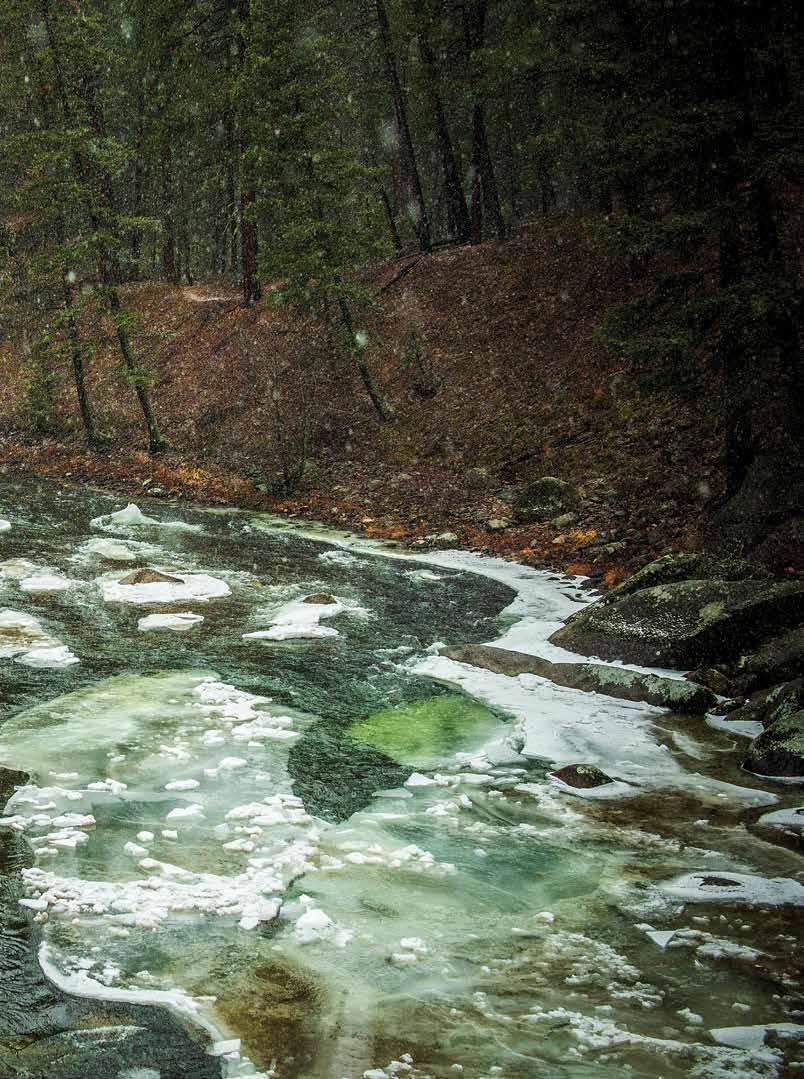

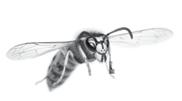

BY ANDREW J. PEGMAN AND PEGGY M c MANUS
talks about great days: Great days. We’ve all had them. A great day is when things go your way, the tides are in your favor, and you can do no wrong. It’s the best feeling in the world. Here are a few scenarios that come to mind when I think of great days in the outdoors.
ON THE BOAT. He is there with his best fishing buddies. He’s wearing old cutoff jeans and a ringer t-shirt, standing on the wet deck of his boat, and a lit cigarette is hanging out of the corner of his mouth. The sun is blazing down in all its glory. He’s hoisting a 30-inch walleye for the camera with a wry smile turning up the corners of his lips. “Unbelievable,” he says, shaking his head.
ON THE TRAIL. He’s got a transistor radio hanging around his neck as he makes his way around the bend and into the woods. He’s holding a carved wooden walking stick in his left hand and a dog leash in his right. His old yellow lab is matching his pace. He smiles and nods as you pass him. He was sick, very sick, for a while, a long time, but now he’s getting his health back. He looks up from the trail, and the blue sky is so bright, and the pines smell so fresh that it almost brings him to tears.
ON THE FLY. Fifth time on the river. She’s 17 years old and determined to catch her first steelhead. She wades out to a new spot, farther upstream this time. It’s dusk, and she stops to watch the steelhead jump from the pool as the mist swirls around them. It feels like a dream. She casts into the drift and lets the fly bounce
along the bottom, over the rocks, keeping the line tight. She feels a gentle tick and sets the hook. A silvery swirl happens below the surface, and the fish strips her line in a frenzy. She can hardly contain her excitement as her heart pounds. She walks the fish towards the gravelly bank and gently captures it in the net. Yes! She says a silent prayer. Somewhere, her grandfather is smiling.
ON THE PAGE. He licks the stamp and seals the envelope again. Off the story goes to the outdoor magazine. He thinks of the Samuel Beckett quote: “Ever tried. Ever failed. No matter. Try again. Fail again. Fail better.” 100 rejections at least, but still, he persists. His dream is still alive until he decides it’s not. Two months pass, and he opens a letter addressed to him. It contains a contract and a check. He sold a story. He did it. And then another arrives a week later. Soon enough, each story he writes finds a home. He can’t believe it. It’s the start of a very good run. For most of us, reminiscing on the great days we’ve had makes us smile. Great days can become the start of good runs. After all, they are our most prized life experiences. But my friend Peggy applies her McManus lens to recall some good runs that didn’t turn out as well as she hoped. She has a very literal and, in my opinion, skewed view that this perfectly fine phrase describes a traumatic situation. I think she got this idea from her father, who was a beloved humor writer. Perhaps you’ve heard of him—Patrick F. McManus.
Peggy’s Response: I suppose that’s an accurate assessment of great days, Andrew. After all, when you grow up with Pat McManus, you learn very quickly to be very clear in your
communication style in hopes of avoiding any confusion that could end up as fodder for his next humorous story. But I still have plenty of memories of good runs, even if mine do involve narrow escapes, misery, and, of course, pain. Lots of it.
For example…
NARROW ESCAPES: I remember one hot July day sometime in the late 60s. My parents, Pat and Bun, had taken my sisters and me up into the Selkirk Mountains in search of the last huckleberries of the season. I was hot and bored and after several hours of whining, I managed to wear Dad down and he ordered me to go wait by our station wagon that was parked precariously along an old logging road a quarter mile or so down the mountainside.
“Don’t think we’re going to share our berries with you,” one of my sisters sneered at me as I passed.
“What berries?” I muttered, half sliding, half stumbling my way down the steep embankment to the car. I was delighted to see that, like me, our car was covered with a thick layer of that special dust that can only be found on old logging roads. It would make for a perfect makeshift blackboard.
An hour later, I had the entire car decorated with peace signs and other doodles that I had drawn into the dust with my finger. I was just sitting back to admire my work when a thunderous pounding arose from the mountain. My heart lurched. Was a herd of elk about to leap out of the forest and trample me? What burst forth from the tree line was far scarier. It took me a second to realize that the streak of color racing toward me was Mom, followed by a huge swarm of angry hornets. She let out a terror-stricken scream at the sight of me.
Luckily, I was fluent in the native tongue of the terrorized and was able to interpret this to mean, “Open the car door, now!”
“Shut the door,” she cried, swatting blindly at the fastest of the hornets that had kept pace with her as she leaped into the front seat of the car. I followed orders and quickly slammed the door
behind her just as the rest of the hornet army reached the passenger window.
A few hornet stings later, I realized the swarm had set their sights on me and I leaped into the station wagon’s back seat, pulling the door shut behind me. I sat for a few minutes, catching my breath, and riding out the worst of the stinging pain. Then I leaned over the front seat and patted Mom on the shoulder.
“Wow, Mom,” I said with admiration. “That was a good run.”
MISERY: When I was in 6th grade, our wild and irrational gym teacher decided it would be fun to make us run a mile. Not only that, we had to do it in under 30 minutes in order to pass the class. Upon hearing the news, I looked incredulously around at the other girls in my class, but none of them seemed fazed by the gym teacher’s ridiculous announcement. With a maniacal laugh, he ordered us out to the schoolyard to run laps. Four laps equaled a mile. Halfway through my first lap, my lungs were on fire, and my legs were rubber. I collapsed onto the grass, gasping and clutching my side. Other students soared past me without breaking a sweat. They were on their third lap.
None too soon, the evil gym teacher blew his whistle. “That’s time,” he announced. “Hit the showers. But remember, if you can’t finish a mile run in a half hour by the end of the term, you’ll be back in my class next year.”
“What’s wrong, Piggly Wiggly?” Dad asked me at dinner that night. (Yes, that was his nickname for me…)
“I have to run a mile in gym class, and I can’t do it,” I said gloomily. “And, if I don’t finish within half an hour, I have to take gym again next year.”
“You can do it,” Dad said. “You just have to work up to it slowly.”
“I don’t think so, Dad,” I said. “The other kids don’t seem to have any problem with it. Most of them ran it in under 30 minutes on their first try.”
“How ‘bout this—I will go running with you every afternoon until you can beat the time,” Dad offered.
THROUGH THE YEARS DAD AND I HAD MANY MORE GOOD RUNS. MOST INVOLVED GIANT SPIDERS, SPOOKED HORSES, VARIOUS HAUNTINGS OR CHARGING COWS IN THE FIELD BY OUR FAVORITE FISHING HOLE.
“Fine, but this is a nightmare,” I groaned.
The next day after school, Dad was waiting for me to take our first run. He had already measured a mile-long route and was anxious to hit the road.
A quarter mile in, I was red-faced and slobbering. I was rather reassured to see that Dad was as well.
“That’s enough for day one,” Dad panted. “Let’s walk back home and try again tomorrow.”
By the end of the first week, we could jog down our driveway without getting a side ache. After a month of nightly jogs, we were able to complete a half mile within the 1/2-hour time limit.
“Our training is really paying off!” Dad said cheerfully one afternoon. “We should be able to run the full mile in another month or so.”
“The test is next week, Dad,” I said. We ran faithfully every afternoon for the next week. On the day before the test, I finally hit the mile mark and was pleased to look back and see that I had beaten Dad by a full block. I looked at my watch. It took me 35 minutes. It was my best time yet, but how would I ever be able to shave another five minutes off during the test?
The next morning, Dad hunkered down next to me as I sat eating Wheaties
at the kitchen table. “Okay, here’s the strategy, Piggly Wiggly,” he said. “Remember when the swarm of hornets chased Mom down the mountain? Oh boy, she ran like the wind that day and barely got stung at all. Now it’s YOUR TURN to outrun the hornets! Remember, today you are running for your life!”
“If you say so,” I said, unconvinced and stood to put my empty cereal bowl in the sink.
The school day dragged on until, finally, it was time for sixth-period gym class. I headed to the locker room to change into my running clothes and then wandered outside, where the rest of the girls mulled around, looking bored and annoyed.
“When the whistle blows, you have exactly one-half hour to complete your mile run,” our gym teacher said with a devilish grin. “Ready, set, go!” he yelled as the whistle blew and he hit the start button on his stopwatch.
I leaped into action and raced across the grass. The first lap seemed to fly by, and then the second. Adrenaline coursed through my veins as I soared along the course. I didn’t even need to use the hornet visualization. My fight-or-flight response was in full “flight” mode. The finish line was in sight when suddenly exhaustion hit.
“The hornets are after me!” I screamed, ignoring the scorching pain in my side and the tears blurring my vision. I stumbled across the finish line and collapsed on the ground just as the gym teacher hit the stop button on the stopwatch.
“Time’s up,” he shouted as if people were still on the course. No one was. I had been the last to cross the finish line.
“Well, I will miss the pleasure of your company in
my class next year,” the gym teacher said. He walked over to where I was crouched on my hands and knees, panting and heaving. He lightly kicked the bottom of my grass-stained running shoe.
“Good run,” he said with a nod and walked away.
I nodded back at him, then turned my head to puke in the grass.
Through the years Dad and I had many more good runs. Most involved giant spiders, spooked horses, various hauntings or charging cows in the field by our favorite fishing hole. Some of these were exceptionally good runs and helped us improve our speed and technique when faced with “Full-Bore Linear Panics,” examples of which can be found in Dad’s books.
Clearly, the training we endured in my sixth-grade gym class paid off, and we happily spent the next several decades
zipping away from whatever dangers came our way. All was well for a very long time. And then it wasn’t.
PAIN. LOTS OF IT: In 2017, we found out that Dad had cancer. In the year leading up to his death, I regularly visited him, and we would sit reminiscing and laughing at all our crazy antics and narrow escapes.
There were so, so many good times to remember. After a while, Dad would stifle a yawn, and I knew it was time for me to leave and let him get some rest. He’d stand and hold out his arms to pull me into a hug.
The hug was our parting ritual. And without fail, before he’d let me go, he’d lean down and whisper in my ear, “We had a good run, didn’t we, Piggly?”
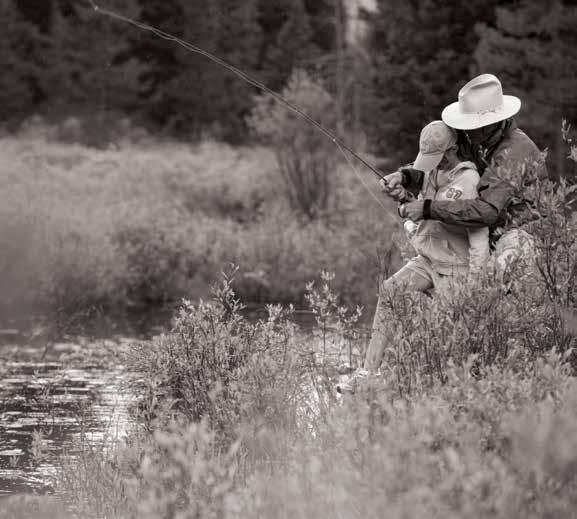
Stories about a moment, or string of moments, that ignited a passion for fishing.
BY CHRISTINE PETERSON
Autumn Harry may not have had a choice. She was born to love fishing. It was in her blood, just like it was in her ancestor’s blood. It helped that her dad was a Water Protector, and her mother worked at a local hatchery and monitored water quality.
But even young anglers born to love fishing can get frustrated.
One day after elementary school, Autumn’s mom picked her up to go fishing on the Pyramid Lake Paiute Reservation northeast of Reno, Nevada. Autumn, who is Numu and Dine and a member of the Pyramid Lake Paiute Tribe, cast and cast with little to show, grumbling louder each time.
“My mom told me, ‘Well, if you smile, and if you’re happy, you’ll catch a fish,’” Autumn said. “And so I threw on the biggest smile from ear to ear, and I sent out my cast, and I just kept that smile on the whole time, and then I had a fish on.”
Autumn was fishing in the famous Pyramid Lake, home of massive and vibrant Lahontan cutthroat trout and the Cui-ui, a native sucker. Her people are the Kooyooe Tukadu band of the Northern Paiute, which means Cui-ui Eaters. The lesson her mom taught her that day—that water is a place that brings joy—stayed with her.
But that innate love still grew over time. Like when, in 2020, as the COVID-19 pandemic ripped across the


country, hitting communities like the Pyramid Lake Paiute particularly hard, tribal leaders decided the shoulder-to-shoulder fishing on Pyramid Lake needed to pause. They shut down fishing on the lake to everyone except tribal members and residents. For eight months, Autumn focused on deepening her relationship with fly fishing in a space where no one watched.
“I got to the point where I knew exactly what depth to fish and where the fish are swimming and what they’re eating and where to cast,” she said. “It was also the time before vaccines, and we weren’t sure if we were going to survive. But I was out there every single day with my dad.”
Week after week for months the two of them cast their lines, laughed and kept fish for their people, delivering the fish to families who, because of the pandemic, no longer had access to their ancestral food.
What Autumn realized in those moments was that everything she’d been taught by her ancestors, her parents and the fish themselves, would soon become her future.
Autumn’s life is littered with stories of falling more and more in love with fishing, as are most of our lives. Maybe it’s a lesson from a family member, or particularly notable vacation or the time someone handed over a rod and said “try.” We all have that moment, or string of moments, that sparked a change and led us down a different path, one where fish, and fishing, would take the lead.
Standing on the end of a dock as the sun glinted off the mayfly-covered water, my seven-year-old daughter and four-year-old nephew squealed at the same time. They cast their rods into the water and watched as 6-inch sunfish slurped their hooks, leaving behind a splash and a ripple. Their lines went tight, and my husband Josh told them to pick up their poles.

That little boy with toobig aviator sunglasses and an even bigger grin didn’t know it at the time, but he would turn into a trout fisherman, Alaskan fishing guide, and eventually a middle school science teacher.
That moment felt, for Josh, like a scene from his childhood when he stood on the banks of a similarly reeded lake in Minnesota, this time next to his grandfather as the older Peterson told him to pick up his rod and hold his line tight.
And that’s what he did.
Over and over, day after day on summer visits from his home in Wyoming to see his grandparents in the Land of 10,000 Lakes, Josh would stand next to his grandpa and reel in sun fish. That little boy with too-big aviator sunglasses and an even bigger grin didn’t know it at the time, but he would turn into a trout fisherman, Alaskan fishing guide, and eventually a middle school
science teacher. His love of fishing and teaching people to fish would turn into a career teaching science to the next generation.
And he traces it all back to those muggy Minnesota days, reeling in one sunfish after another, then carefully scraping their scales, emptying their bellies and breading and frying their flaky flesh in a pan of hot oil.
So when his little sister asked us to go back to Minnesota with her and her four-year-old son to teach him to love fishing, Josh had no choice but to say yes.
The trip became the first taste of fishing for our nephew, but may have, somewhat ironically, become what made our daughter into a fisherwoman. She, like Autumn, has spent her life fishing. From the time she could stand, she’s been casting into Wyoming’s streams, creeks, rivers, lakes, beaver ponds and even a culvert or two. But it wasn’t until that dock in Minnesota that all those lessons seemed to come together like a school of herring, taking shape as she realized the magic waiting for her underneath the water’s surface.
As an adult, Matt Miller has built a life around water, fish and fishing. His interest in fish spans their natural history, their ecology and the simple thrill that comes from feeling a tug at the end of his line. He even wrote a book about it, called Fishing Through the Apocalypse: An Angler’s Adventure in the 21st Century. But he’s much less interested in the hooked jaw of a trophy brown trout or pop of color from a rainbow trout than he is in the native fish swimming through whatever water he’s standing in or alongside. He wants to see and understand the fish that evolved in those streams, rivers and lakes.
While as a young boy growing up in rural Pennsylvania, he certainly loved to fish. But it wasn’t until his dad and a group of buddies took 14-year-old Matt on a fishing trip to Ontario, Canada,
that he realized just how big a part of his life fishing would become.
“The fishing, by Canadian lake standards, wasn’t great, but I fished constantly, from sunrise to sunset every day,” he said. “It was one of those trips where the guys were playing cards and drinking beer, and I just did my thing.”
He took a tackle box full of big lures for pike, but after one pike on the first day, the bite stopped. So he found some smaller hooks to use for perch, crappie and rock bass, and he improvised with his baits, trying anything he thought could work. Then one day while eating lunch on an island, he took scraps of ham, wrapped them around a hook, and cast. A huge yellow perch bit.
“There were loons calling, and it was beautiful, and everything was there: the love of nature, of fishing, of dreaming of travel, it brought it altogether,” he said. “I realized this is what I want my life to be.”
Autumn’s journey with fishing didn’t stop after those months on the water, laughing and fishing with her dad and feeding people. She realized she could use what she knows, like her ability to pinpoint exactly how deep fish are suspended and what they will bite, to teach other anglers not only how to catch Lahontan cutthroat but also about the sacredness of water and the sacredness of fish themselves.
“My dad has this wonderful quote, ‘What is good for the fish is good for the people,” she said. “If the fish are good,
then that means the water quality is good, that means the people are healthy.”
So in 2021, she became one of only three of Pyramid Lake’s Indigenous guides. She named her company Kooyooe Pa’a Guides, requiring anyone who books with her to say her people’s name for Pyramid Lake.
And like Matt, Josh, Miriam and maybe even my nephew, those moments that ignited Autumn’s passion for fishing keep growing, working in tandem as the fish teach her and the rest of us lessons about not only about how to catch and respect them, but also be in better relationship with the water.
“My dad has this wonderful quote, ‘What is good for the fish is good for the people. If the fish are good, then that means the water quality is good, that means the people are healthy.”— Autumn Harry





The Future of America’s Coldwater Resources
TU Costa 5 Rivers program.
pg 60
LITU Project on West Brook
TU’s Long Island Chapter collaborates on the West Brook.
pg 61
Aquatic Invertebrate Survey on the Clinch River
Tennessee’s Clinch River Chapter partners with the Tennessee Valley Authority. pg 62
Stream Champion
Patrick Finnegan
pg 64
Tools & Tips
Streamside Science, Regional Rendezvous & CX3 Twin Cities and more.
pg 66



The TU Costa 5 Rivers program is proof that the next generation of anglers is a conservation force to be reckoned with.
As the national network of conservationfocused college fly-fishing clubs, 5 Rivers hosts four rendezvous events each year. They provide students an opportunity to engage with the TU mission, connect with other college anglers and collaborate with fellow club leaders.
At a recent rendezvous, clubs from the University of Utah, Colorado State University and the University of Wyoming met in Steamboat Springs, Colorado. Steamboat
is an ideal location with plenty of fishing, multiple successful TU projects and campsite capacity for nearly 80 college students. That’s right, from just these three clubs, nearly 80 anglers showed up for the event. Students arrived Friday afternoon, and with rain in the forecast, they quickly set up their tents. Once camp was built, students hit the river near camp and found quick success with the willing local cutthroat trout. As nighttime rolled around, they lit a fire, s’mores appeared and college rivalries were thrown to the wayside as people who met hours ago became best friends.

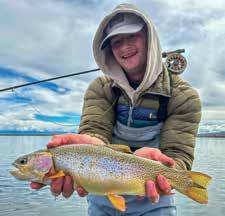
Saturday kicked off with a visit to the completed Lost Dog Creek TU project, which protects and preserves seven miles of native Colorado River cutthroat habitat through the construction of two fish barriers. The project is a resounding success, and students appreciated seeing the work of TU firsthand. After visiting the project site, students explored the Steamboat area with an afternoon of fishing and trash cleanup.
Everyone returned that evening with countless stories of fish caught, fish missed and wild pieces of trash they found. One of the best stories of the trip came from


a group of six lady anglers who fished together. A car drove past them as they were rigging their rods. The driver saw them, and quickly turned around. As the car approached, the group’s nerves rattled, wondering if they were in the wrong place at the wrong time. Their worries quickly dispersed when a woman in waders jumped out of the car with a huge smile on her face. She was a local fly-fishing guide and just felt the need to stop and tell this group of ladies how “bad ass” it was to see a group of women anglers fishing together.
As the groups returned to camp, raffle items were passed out with gifts from Costa Sunglasses, Simms, Yeti, TroutRoutes, Turtlebox, onWater and Umpqua. A huge thank you goes out to all these groups that make 5 Rivers events possible.
When Sunday morning arrived, the group cleaned up camp and sat down for a breakfast discussion about the state of coldwater conservation. With much learned, new fishing friends gained and less trash on Steamboat’s waterways, they considered the weekend a success.
These students are the future of America’s coldwater resources, and the future is bright with them on rivers and at college campuses across the country.
—Cliff Watson
Aweir dam at the outflow of West Brook Pond in Bayard Cutting Arboretum State Park suddenly failed in 2019. The dam collapse quickly exposed remnants of a tributary of the Connetquot River, historically known as West Brook. The new West Brook then became one of very few unimpounded freshwater streams on Long Island. The brook’s riparian zone soon revealed a host of native plants, 120-year-old stumps of Atlantic white cedar and unfortunately, large stands of phragmites. TU’s Long Island Chapter recently joined with the Seatuck Environmental Association and New York State Department of Environmental Conservation in an “Earthday Workday” for a “phrag fight.” Our short term goals are to contain this invasive species and give the stream’s banks a chance to recover. We plan to continue working with our associated groups to help West Brook regain its historical course, beauty, plant ecology and, hopefully, brook trout population.





TU’s Clinch River Chapter in Norris, Tenn., wanted to learn more about the aquatic insects in the Clinch River. The idea was discussed during board meetings, resulting in a plan to conduct three level one benthic macroinvertebrate samplings in the spring, summer and fall.
The Tennessee Valley Authority currently conducts aquatic insect surveys every five years. Our chapter wanted to not only learn more about the health of our tailwater through aquatic insects, but learn if the ever-changing flows and water levels impacted insect populations.
The first survey was conducted Saturday May 4, 2024, and the second conducted Saturday August 24, 2024. In addition to participants from TVA and the Clinch River Chapter, approximately 15 students from the Wildlife & Fisheries school at the University of Tennessee, Knoxville, joined in for both surveys.
Leading the surveys were Dave Matthews, Aquatic Zoologist at TVA, and
Dennis Baxter, Aquatic Zoologist at TVA, retired.
The survey teams met at 7:30 a.m. on both Saturdays, at the Miller Island boat ramp on the Clinch River, approximately 25 miles north of Knoxville, Tenn. Dave Matthews kicked off the morning events with a “Safety on The Water” review to ensure all participants understood that safety was first and foremost.
A special thanks to TVA for suspending water generation for the morning to allow safe wading access in the river for the survey.
The May 4 survey group split into three teams, led by Dave Matthews, Dennis Baxter and Alec Nance, the President of the American Fisheries Society at the University of Tennessee, Knoxville. Dave and Alec’s teams surveyed the river on each side of Miller Island while Dennis’ team hit the water below the recently refurbished weir. The August 24 survey group split into two teams, led by Dennis Baxter and Bill Toth,
CRCTU President. Both teams surveyed the river below Norris Dam and above the weir as well as two locations farther downstream, above the Highway 61 bridge, near Clinton, Tenn.
Using aquatic dip and kick nets purchased by the Clinch River Chapter and spec’d to TVA collection standards, the teams collected numerous samples from overturned rocks and logs and stirring upriver bottom sediment. The aquatic invertebrates were placed in jars containing a 5 percent formalin solution for preservation for further identification and analysis.
After approximately two hours of collection the teams safely returned to the launch site where Dennis Baxter showed the University of Tennessee students how the survey data would be summarized in a TVA reporting format and further quizzed them on what type and how many bugs they had collected.
Following both surveys the teams were treated to lunch courtesy of the Clinch River Chapter.
Between the two surveys members of the Clinch River Chapter had the opportunity to view the survey one bugs under microscopes at the TVA Engineering Labs in Norris, Tenn. Following survey two, Dave Matthews from TVA will present the team’s findings at the September 2024 Clinch River Chapter monthly meeting.
Our chapter wanted to not only learn more about the health of our tailwater through aquatic insects, but learn if the ever-changing flows and water levels impacted insect populations.



Send us a 300-500 word write up on your projects and events along with a photo or two and you could see your chapter in the pages of TROUT. Send your submission to Samantha.Carmichael@tu.org.
If you’re thinking about taking the plunge to be a TU Life Member… or signing someone else up… maybe “renewing your vows” to get a special rod, this is undoubtedly the best window to do it in. We’re offering a limited, numbered series of the new Orvis Helios rod that’s causing buzz in the fly-fishing world for a special life membership donation of $1,500. These rods have unique graphics, and you can choose between a 9-foot, 5-weight option or a unique 8-foot 5-inch, 7-weight option. But you should act fast, because once the numbered series is sold out, that’ll be that. We have fished the rods in numerous situations—from English chalk streams to Vermont (where we toured the Orvis factory)… to Michigan, the Rocky Mountains and the Low Country for redfish—and yes, we will vouch that the new Helios is all that when it comes to pinpoint accuracy and smooth casts at various ranges. We collaborated with Orvis with you in mind and landed on something pretty special. Go to tu.org/LifeRodOffer or use this QR code to view these special rod options, get an instant classic and make a lifetime commitment to making and keeping trout and salmon rivers healthy.




5-weight option

BY SAMANTHA CARMICHAEL
Patrick Finnegan may be a retired special agent with Forest Service law enforcement out of Grangeville, Idaho, but his dedication to protecting and doing what is good for the land didn’t retire. When dredge miners deliberately ignored regulations in mining on the South Fork of the Clearwater River, practically in Finnegan’s backyard, he showed up with no intention of backing down.
Finnegan’s work to keep mining companies working within regulations is based in the logic that dredge mining is going to continue to happen, so it is everyone’s duty to hold the companies to the regulations placed on them.
In 2014 to 2015, the forest service was embroiled in some high-profile situations and the red tape of mining regulation meant the destruction of the South Fork was far
down the task list. So, Finnegan took it upon himself to reach out to the Idaho Conservation League, and they hired him on a contract to monitor the suction dredging of the river. In 2015, out of state mining companies rolled in to protest the regulations but with diligent enforcement and the backing of regulations that allowed mining if companies mitigated for potential harm. They got all the miners under permit and regulation in 2016.
Then a California mining company showed up and declared they were not held to the regulations that everyone else was following. Finnegan knew that they were wrong and needed to be challenged and he was going to be the guy to do it. Armed with a camera, he showed up and continued to show up to document violations and wrongdoing. With his evidence in hand, the Idaho Conservation League used
the ability afforded by the Clean Water Act for citizens to sue other citizens and they sued Shannon Poe, the head of the California mining company.
“I believe the citizens prevailed and we benefited from that. There is still mining going on, but it is all under permit now,” Finnegan said.
The case and evidence gathered by Finnegan has given law enforcement the knowledge to regulate and punish mining violations around the country leading to more companies mining with in regulations and being held accountable.
but they also had questioned Finnegan’s mindset for going toe to toe with the companies who were angry.
“TU is good at working with agencies and politicians. I am right there with my feet wet looking
at the activity,
and
if those
guys decide to yell at me, I know TU and the agencies will be there to back me up.”
Currently, Finnegan is monitoring mining on the Salmon River, “Dredge mining without a permit isn’t going to fly around the country because of the Poe case. But it is an ongoing Salmon River problem. It is easy to monitor. The DEQ has full CWA authority and they have to enforce it. They are in a difficult position to figure out how to enforce it and it is frustrating the time it takes, but I know how things go. I hope that as we are speaking, they have people at the river warning miners that they are on a bad path that leads to legal proceedings and fines.”
Finnegan says his work in monitoring the mining on the rivers is just him using the skills he has relied on for years. In the video that his son shot and then the Idaho Conservation League put out, the public could see what was happening. Everyone could see what was being destroyed
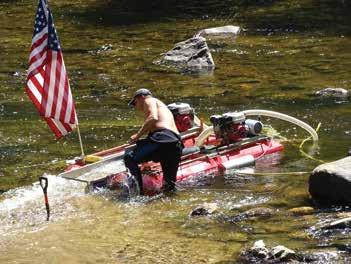
“Some thought it was dangerous, but to me I feel like I am old enough, people need to stand up for what they believe in. I didn’t feel I was in danger. They are angry because I am there and they don’t want shut down. That’s just the way it is in dealing with them, some are friendly and know me from outside the issue and say ‘Hi’ and others are profane almost from the start… I am a lot more careful than people might think. I have had people go with me and they expect the excitement, and I have had to tell them I read body language and the situation. I might not even contact the guys and if my gut says today isn’t the day I might drive right by. There are boundaries you must set knowing that some places require more precautions before heading out. But I can’t stop protecting the river I love.”
Finnegan said, “TU is good at working with agencies and politicians. I am right there with my feet wet looking at the activity, and if those guys decide to yell at me, I know TU and the agencies will be there to back me up.”
“Anyone can do this. I am happy to hear about people getting out and looking around. TU steps up to do their part, but we often don’t hear about the small local projects. Even so, they are happening. I don’t know what we would do without TU staff. They work pretty quiet, but they get after the important things.”

The first step in caring for and recovering our rivers and streams is fully understanding what ails them and where the best habitat exists.
Are there dams disconnecting the critical spawning grounds in the headwaters from the nutrient-rich waters of the main stem system where trout can grow large and thrive? Have flooding and land use practices degraded in-stream habitat and reduced the availability of cover and structure? Is the riparian buffer—the vegetation along the river’s edge—too narrow, too sparse, beset with invasive species or non-existent?
Where do the trout spawn in the river system? Where do they find refuge from the summer’s heat? Are there springs, seeps and mountain streams providing the cold, clean water they need to survive?
All of these questions have answers and TU’s Community Science tools make it possible for you to help your local chapter, your state staff and the agencies and partners we work with find the answers. From assessing stream health with the RIVERS app to mapping the spawning areas with the REDDS survey tool and more, you can use your waders and your smartphone to add important knowledge to our overall plans for restoring these waters.
Connect with our community science resources and learn which tools might be right for your rivers online at www.tu.org/ communityscience.





Join Us In California, Utah, West Virginia and Minnesota in 2025
Join hundreds of TU volunteers, members, supporters, partners and staff from across the country at one of three Regional Rendezvous or CX3, TU’s annual meeting! Whether you connect with us in California, Utah, West Virginia or Minnesota this year, you’ll experience some great fishing, enlightening presentations, inspiring dialogue and engaging conservation learning with those who share your dedication to TU and our mission.
Pacific Rendezvous
Pleasonton, California – Feb. 28-March 2
Rockies Rendezvous
Sandy, Utah – March 28-29
Eastern Rendezvous
Shepherdstown, West Virginia – April 25-27
CX3 Twin Cities
St. Paul, Minnesota – September 24-28
TU Rendezvous and CX3 are occasions to be inspired—by the work of TU staff, lessons from volunteer leaders, and conversations with newfound friends. They are also an excellent opportunity to discuss the unique issues facing each region as well as a chance to network and build relationships with fellow TU volunteers and staff.
Learn more at www.tu.org/regionals


Events
Locations
As a TU chapter or council volunteer leader, one of the most important roles you can play in growing our impact is to create the local opportunities for new supporters to connect with TU in ways that are meaningful to them.While many conservationists and anglers are attracted to the great programs and projects we offer, sometimes they need us to meet them where they are so they feel comfortable taking that first step through the TU door.
Winter is a great time to plan for the year ahead, and as you and your board members consider all you will add to your community calendar, be sure to consider ways you can make your events more inclusive, more attractive and more accessible to the audiences you are trying to reach by doing the following:
• Move the Mountain: If all of your chapter activities take place in one corner of your territory, consider the impact this may have on creating opportunities to connect with people who have busy lives in other areas and look for specific ways to host events, activities, fishing trips, volunteer days and more in communities where you are not as active.
• Communicate the Change: You may have a very clear goal to get more people active in the chapter and diversify your membership, but if that goal is not visible to those outside the board room, then you are missing the chance to signal the changes you are making. Be sure to emphasize your chapter's efforts to grow a more diverse community, and since seeing is believing, ensure the imagery used in your communications reflects the community you are hoping to become.
• Elevate the Events: People want to get their hands dirty and their waders wet making the rivers they love cleaner and spending time on the water with friends new and old. Give them more of that this year and try out new events like a trash cleanup with a fun contest and awards, a fly-tying night at a local bar or brewery in a more urban setting, a tree planting in a suburban park frequented by families, and more events that go beyond the traditional monthly meeting and the weekend fishing trips.
Learn more and connect with your Volunteer Operations staff and more great resources in the online Tacklebox at www.tu.org/tacklebox.
BY CHRISTINE PETERSON
I’m not sure you meant to be quite so funny the first time you said it, which is maybe why it was so funny.
You were 5, and we’d just loaded back up in our friends’ truck after a morning of fishing on a lake outside of town. You’d caught two nice rainbow trout, fat and healthy ones from a summer of good eating. Your dad and I had each only caught one.
We chatted about the day, how nice the weather had been and debating what species of ducks had landed near us, when from the back seat you chirped: Dad, why do you think I caught two fish, and you only caught one?
It might have been the sincerity with which you said it, or the fact that you followed it up with: I just don’t get it, I’m only five. Regardless, it was one of the funniest things we’d heard in months.
You’re right, you were only five, and you had caught two nice rainbow trout, even if your dad had been the one who rigged your rod and baited your hook.
Fast forward almost three years, and we’re in a canoe in Quetico, a Canadian wilderness area that flows indistinguishably into the American Boundary Waters Canoe and Wilderness Area, the same ecosystem separated by an invisible and arbitrary international border. It’s been raining for over 48 hours, and the mosquitoes might be the worst I’ve ever encountered. Even by Minnesotan standards, these mosquitoes are bad.
The night before, after a day when we hadn’t yet figured out our head net game, you asked me to count the bites on your face. I wasn’t sure you wanted to know, and wasn’t sure I wanted to know, but I counted anyway.
I found 47 bites. Twenty-seven on your forehead alone. And something had bit you close enough to your eye that it was swollen three-quarters shut.
But here we are, in a canoe, as rain pelts the side of your face against a cheap, green, plastic poncho I bought before we launched when I realized that your rain jacket wasn’t actually waterproof.
Your dad and I keep the canoe more or less adjusted so the rain doesn’t smack us squarely in the face, though sometimes there’s only so much we can do. It should have been a recipe for misery. None of us should be having fun. And yet, when you reel in that 7-pound small-mouth bass from under that log, a grin engulfs the bottom half of your face.
Dad, why is my bass bigger than any you’ve caught? I’m only 7!
And this time, you’re using your Shakespeare spinning fishing rod bought just for you, that you cast where you wanted using a glittery white paddle-tail lure you helped pick out and chose to use today. You have had very little instruction from your dad and I when you cast, just enough to minimize the snags.
And it continues, your dad using his 8-weight to chuck streamers hoping he can catch something on a strip, and you reeling in bass and northern pike cast after cast, keeping count and poking fun each time.
Then we realize the only thing more entertaining than a 5-year-old talking smack after catching more rainbow trout than us is a sincere 7-year-old in a rainstorm with a puffy face asking: When are you going to catch a big fish like this one?
I’m not sure your dad has ever been so proud, both in your unnatural ability to give him grief and also the pure joy you found in catching those fish.
That’s the thing as we get older, it’s still fun to catch big fish, but it’s more fun to watch you.
Love, Mom

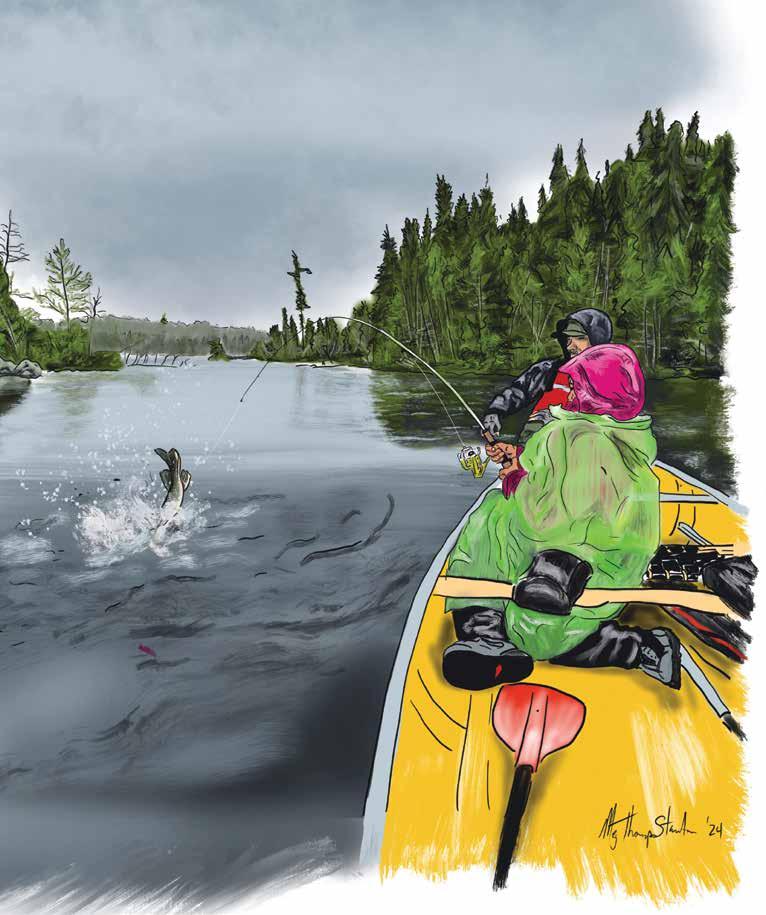
Then we realize the only thing more entertaining than a 5-year-old talking smack after catching more rainbow trout than us is a sincere 7-year-old in a rainstorm with a puffy face asking: When are you going to catch a big fish like this one?
Guided day trips near Denali National Park for Arctic Grayling in the heart of the Alaska Range. www. denaliangler.com.
Turn Key Fly Fishing Vacations in Missoula Montana Trip includes All food and drink, ground transportation, accommodations and 3 days guided float trip on Blackfoot, Clarkfork, Bitterroot and Rock Creek $2500 Single / $2250 Double www.mmtroutadventures.com. Call for details 602-448-4834
Exclusive Fly-Fishing Club for you and your guest. Enjoy a mile of wild, trophy trout stream in western N.C. www.armstrongflycasters.com
Pennsylvania Guide Service, Sky Blue Outfitters, ½ day, full day and overnight trips available. Penns, Spring, Letort, Little Juniata, Pine and many more. Call 610-987-0073 or visit www.skyblueoutfitters. com for details.
Reel in Relief with Specialized Fly Fisherman Physical Therapy! Expert Care for Anglers, Onsite and Online: Are you an avid fly fisherman struggling with injuries that dampen your fishing experience? Our specialized Physical Therapy services cater to the needs of passionate anglers. We’ll work closely with you to create a personalized rehabilitation program, getting you back to fishing. Call 720-352-0678 for a free 15’ consultation. www.neuromuscularstrategies. com. Mike Kohm PT, BS. Schedule Online: Boulder https://mikekohmpt-boulder.youcanbook.me/
Property For Sale By Owner - 17.1 acres along the banks of the Beaverkill River - one of the most iconic trout streams in the U.S. The property features 3 auxiliary buildings (including a 3-story barn), a pond for stocking trout, a brook with an outlet to the Beaverkill, an orchard and two meadows. The bluestone foundation from the original farmhouse serves as a perfect location to build a custom residence.
With the purchase of the property, the owner is entitled to an individual membership at the Beaverkill Stream Club which provides 4 miles of private river rights in perpetuity on the Beaverkill for fly fishing; as well as a membership option to the Beaverkill Mountain Club with access to about 65 miles of scenic trails. In addition, the property benefits from a local conservation easement that will preserve the pristine beauty of this unique area for generations to come.
Whether you are looking for a permanent residence, or a vacation home, this is a rare opportunity to own a tranquil, private country property in the Catskills, just two hours outside of New York City. Send inquiries to beaverkill.farm1@gmail.com
4-piece bamboo flyrods handmade with bamboo ferrules. cgbamboorods.com chuck-g@comcast.net”
Handcrafted wooden fly-fishing furniture and fly boxes – Handcrafted fly fishing furniture and wooden fly boxes. Built from the finest hardwoods. Visit woodbyroy.net or contact Roy at 804-930-2113.
Fly or Spin Rods- Veteran Owned www.stanleycanyon.com james.a.boyless@stanleycanyon.com
Custom Fly Rods built to your exact specifications. Carbon fiber blanks, Portuguese burl cork handles, nickel silver seats, fine wrapping threads. Professional Certified Rod Builder. LakeLady Custom Rods. rodbuilder@lakeladyrods.com
Custom made wooden fly boxes, no two are alike. Contact Jim at jimwhip@q.com for details
EZ-P Waterproof Wader Zipper – $90 Installed in any brand. Guaranteed for the life of your waders. Pressure tested for dry suit SCUBA. Contact: www.troutboomer. biz, bjuniata@verizon.net or 814-569-8843.
BAMBOO RODS Buy Sell Consign www.coldwatercollectibles.com (616) 884-5626
No Touch Hook Release™. This tool saves fish, flies and cold hands. Easy to use, it releases fish quickly, even for #22 hooks and bead heads. Learn more and buy: NoTouchTrout.com ($20 ppd)
FLY ROD RULER Measure your catch with a Rodrule. The micro-thin Rodrule adheres to your rods without hampering the action or finish. Guide approved! Order at: www.rodrule.com
Sermons in Stones - Tales of family, friends, and flyfishing by David Ammons is a collection of eighteen beautifully crafted short stories on the author’s life experiences in a “mountain wilderness carved by a river”. Five-star rated on Amazon! Visit www.puremountainliving.com
WEST VIRGINIA: GO TROUT FISHING by TU Life Members. WV is home to some of the most wild and wonderful trout streams in the US! Find your next trout fishing destination at GoTroutFishing.com Fly or Spin Rods Veteran Owned www.stanleycanyon. com james.a.boyless@stanleycanyon.com
Tributaries: Fly-fishing Sojourns to the Less Traveled Streams: “We’re recommending it because we think it’s the coolest concentration of Pennsylvania- (and a bit Catskill-) centric short essays we’ve read.” — Trout magazine. Visit www.coastforkpress.com
Full Circle by David Van Lear is a book of short stories about adventures had during a lifetime of fishing, mostly fly fishing, including being treed by a mother grizzly in Yellowstone and nearly falling to his death when he tried to climb down into the Black Canyon of the Gunnison—don’t try it! The author has dealt with a mild form of bipolar disorder called cyclothymia most of his life and used fishing as a
positive addiction to help stabilize his mood swings and have a productive and happy life. Van Lear is a life member of Trout Unlimited and received their Distinguished Service Award in 2010 for leading his chapter’s efforts to restore stream habitat and helping to bring back the brook trout to South Carolina’s headwater streams. Available at Amazon for $11.99.
FLY FISHING THE SOUTHERN ROCKIES: Small Streams & Wild Places by TU Life Member Paul Downing. Covers Colorado, New Mexico and Wyoming. Available at Amazon.com. Special Club Discount—$20/ppd. Contact majesticpress@aol.com.
Beautiful four-color fly-fishing poster will look great on your man cave, office, or den wall! Wholesale inquires welcomed. Details www.fishingthoughts.com
Reach more than 150,000 anglers for just $2.25/word ($2.05/word for members). Send text of ad and payment to:
TROUT Classifieds 1700 N Moore Street Suite 2005 Arlington, Virginia 22209-2793
Ads may be faxed to (703)284-9400 or e-mailed to samantha.carmichael@ tu.org
Classifieds must be prepaid. Count phone number, fax number, ZIP code, street number, abbreviations and email or website address as one word each.
March Deadline: February 10, 2024.
To request a media kit for display advertising, call (703)284-9422
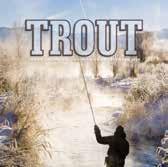
Trout Unlimited Business members are TU ambassadors in protecting, restoring, reconnecting and sustaining North America’s coldwater fisheries. To become a TU Business Member, contact Zack Dingus at (571) 919-8083 or Zachary.Dingus@tu.org. Outfitters Guides Lodges
Alaskan Angling Adventures LLC.
Mike Adams Cooper Landing, AK 99572 (907) 595-3336 alaskananglingadventures@gmail.com www.AlaskanAnglingAdventures.com
Alaska Drift Away Fishing Jeremy Anderson Sterling, AK 99672 (907) 529-8776 info@guidekenairiver.com www.guidekenairiver.com
Alaska Fly Fishing Goods
Bradley Elfers Juneau, AK 99801 (907) 586-1550 brad@alaskaflyfishinggoods.com www.alaskaflyfishinggoods.com
Alaska Kingfishers
Rob Fuentes Dillingham, TX 99576 fish@alaskakingfishers.com www.alaskakingfishers.com
Alaska Rainbow Lodge King Salmon, AK 99613 info@alaskarainbowlodge.com www.alaskarainbowlodge.com
Alaska Sportsman’s Lodge
Brian Kraft Kvichak River – Lake Iliamna, AK (907) 227-8719 brian@fishasl.com www.fishasl.com
Alaska Trout Guides
Josh Hayes Sterling, AK 99672 (907) 598-1899 josh@alaskatroutguides.com www.alaskatroutguides.com
Alaska Troutfitters
Billy Coulliette Cooper Landing, AK 99572 (907) 595-1212
info@aktroutfitters.com www.aktroutfitters.com
Alaska’s Bearclaw Lodge Rob Fuentes Dillingham, AK 99576 (907) 843-1605
info@bearclawlodge.com www.bearclawlodge.com
GOLD LEVEL
Alaska Wild Caught
Seafood
Matthew Luck Ketchum, ID 83340 (208) 720-4226
matt@alaskawildcaughtseafood.net www.alaskawildcaughtseafood.net
Aleutian Rivers Angling
Dan, Jeff & Pat Vermillion Livingston, MT 59047 (888) 347-4286 pat@sweetwatertravel.com www.sweetwatertravel.com
GOLD LEVEL
Bear Trail Lodge
Nanci Morris Lyon King Salmon, AK 99613 Lodge: (907) 246-2327
Cell: (907) 469-0622 gofish@bristolbay.com www.fishasl.com/naknek/
Bristol Bay Lodge
Steve Laurent Bristol Bay, AK Office: (509) 964-2094
Cell: (509) 899-0734 slaurent@bristolbaylodge.com www.fishasl.com
Chasing Tales Alaska
Shawn Coe Sterling, AK 99672 (907) 741-7944 chasingtales.alaska@gmail.com www.chasingtalesalaska.com
Classic Casting Adventures
Tad Kisaka Sitka, AK 99835 (907) 738-2737 tadkisaka@hotmail.com www.flyfishsitka.com
Cooper Landing Fishing Guide, LLC
David Lisi Cooper Landing, AK 99572 cooperlandingguide@gmail.com www.cooperlandingfishingguide.com
Copper River Lodge Pat Vermillion Iliamna, AK 99606 (406) 222-0624 info@copperriverlodge.com www.copperriverlodge.com
Crystal Creek Lodge Dan Michels King Salmon, AK 99613 (907) 357-3153 www.crystalcreeklodge.com info@crystalcreeklodge.com Deneki Outdoors
James Kim Anchorage, AK 99503 (800) 344-3628 info@deneki.com www.deneki.com
EPIC Angling & Adventure
Don Mutert
Alaska Peninsula, AK (512) 656-2736 don@epicaaa.com www.epicaaa.com
Kulik Lodge
Bo Bennett Anchorage, AK 99502 (907) 243-5448 (800) 544-0551 info@bristoladventures.com www.kuliklodge.com
Lakeview Outfitters
Phil Hilbruner
Cooper Landing, AK 99572 (907) 440-4338 info@lakeviewoutfitters.com www.lakeviewoutfitters.com
Lost Boys Fishing LLC
Equinox Cameo Padilla & Brooks Areson Sitka, AK 99835 (907) 738-4736 info@equinoxalaska.com www.equinoxalaska.com @equinoxalaska
Explore Kenai
Dallas Voss Soldotna, AK 99669 (907) 690-6477
Contact@explorekenai.net www.explorekenai.net
Fish Em, LLC
Travis Price Alaska (907) 317-4706 Travis@fishem.net www.fishem.net
Fishe Wear
Linda Leary Anchorage, AK 99503 (907) 854-4775 linda@fishewear.com www.fishewear.com
Frontier River Guides of Alaska
Marty Decker Anchorage, AK 99523 info@frontierriverguides.com www.frontierriverguides.com
Grizzly Skins of Alaska
Rochelle Harrison and Phil Shoemaker
King Salmon, AK 99613 (907) 376-2234 info@grizzlyskinsofalaska.com www.grizzlyskinsofalaska.com
Kenai River Drifters Lodge
Jonathan Hulcher
Cooper Landing, AK 99572 (336) 354-9582 info@drifters.com www.drifterslodge.com
Kenai River Trout Anglers
Josiah Brown
Cooper Landing, AK 99572 (907) 599-0086
Kenairivertroutanglers@gmail.com www.kenairivertroutanglers.com
Kenai Riverside Fishing Cooper Landing, AK (800) 478-4100 info@kenairiversidefishing.com www.kenairiversidefishing.com
Kenaiflyfish
Ian McDonald Sterling, AK 99672 (907) 301-6957
Kenaiflyfish@gmail.com www.Kenaiflyfish.com
Drew Petrie Anchorage, AK 99502 (907) 202-6422 fishguide@kenaineverland.com www.kenaineverland.com
Mister Kenai Sportfishing
Jack Mister Sterling, AK 99672 (301) 752-3551 misterkenaisportfishing@gmail.com
No See Um Lodge
John Holman King Salmon, AK 99613 (907) 232-0729 john@noseeumlodge.com www.noseeumlodge.com
Outer Coast Charters
Captain Christopher Paul Jones Sitka, AK 99835 (907) 623-8290 contact@outercoastcharters.com www.outercoastcharters.com
Outgoing Angling
Jordan Carter Anchorage, AK 99507 (907) 830-9545 jcarterflyfishing@gmail.com www.outgoingangling.com
GOLD LEVEL
Pride of Bristol Bay
Steve and Jenn Kurian Bloomsburg, PA 17815 (570) 387-0550 contact@prideofbristolbay.com www.prideofbristolbay.com
Rainbow King Lodge Iliamna, AK 99606 800-458-6539 info@rainbowking.com www.rainbowking.com
Royal Coachman Lodge Pat Vermillion Dillingham, AK 99576 (406) 222-0624 info@royalcoachmanlodge.com www.royalcoachmanlodge.com
Tikchik Narrows Lodge Bud Hodson Anchorage, AK 99522 (907) 243-8450 info@tikchik.com www.tikchiklodge.com
Undisclosed Excursions, LLC Ethan Welch Juneau, AK 99801 (907) 982-9674 undisclosedexcursions@gmail.com www.flyfishjuneau.com
Wilderness Place Lodge
Jason Rockvam/Cory Wendt Anchorage, AK 99519 (907) 733-2051 wildernessplacelodge@gmail.com www.wildernessplacelodge.com
ARIZONA
Arizona Flycasters
Gene Hechler Phoenix, AZ 85016 (520) 203-4140 president@azflycasters.org www.azflycasters.org
AZ Fly Shop
Chris Rich Phoenix, AZ 85032 (602) 354-8881 info@azflyshop.com www.azflyshop.com
Destinations Fly Fish
Steve Berry Phoenix, AZ 85020 (480) 223-3117 steve@destinationsflyfish.com www.destinationsflyfish.com
Financial Planning First, LLC. Matthew Sullivan Tucson, AZ 85718 info@fpftucson.com www.financialplanningfirst.com
Imus Investment Partners
Gary Imus Tucson, AZ 85718
Direct: (877) 813-4985 or (520) 314-1301
Fax (520) 529-4031
Cell (520) 991-5317 gary@imusinvestmentpartners.com www.imusinvestmentpartners.com
Lees Ferry Anglers Marble Canyon, AZ 86036 (800) 962-9755 anglers@leesferry.com www.leesferry.com
Oxbow Ecological Engineering, LLC
George Cathey Flagstaff, AZ 86005 (928) 266-6192 george@oxbow-eco-eng.com www. oxbow-eco-eng.com
Spiral Creative Services Graphic Design
Susan Geer Gilbert, AZ 85234 (602) 284-2515 Susan@spiral-creative.com www.spiral-creative.com
GOLD LEVEL Wilkinson Wealth Management
Eb Wilkinson Tucson, AZ 85715 (520) 777-1911 (877) 813-4985 eb@wilkinsonwealthmgmt.com www.wilkinsonwealthmgmt.com
ARKANSAS
Dally’s Ozark Fly Fisher
Steve Dally Cotter, AR 72626 (870) 435-6166 info@theozarkflyfisher.com www.theozarkflyfisher.com
Freedom Fire Pro Michael Cormier Rogers, AR 72756 (479) 631-6363 mcormier@freefirepro.com www.freefirepro.com
Natural State Fly Shop
Jane Hatchet Cotter, AR 72626 (870) 471-9111 (870) 321-2792 (Cell) flyfishcotter@gmail.com www.naturalstateflyshop.com
Peglar Real Estate Group
Matt Hershberger Mountain Home, AR 72653 (870) 405-4144
matt@peglarrealestate.com www.peglarrealestate.com
The White River Inn
Steven Sonnamaker Cotter, AR 72626 (870) 430-2233
info@thewhiteriverinn.com www.thewhiteriverinn.com
Two Rivers Fly Shop
Dru Zametto Norfork, AR 72658 tworiversflyshop@gmail.com
White River Trout Lodge
Jo Anna Smith Cotter, AR 72626 (870) 430-5229 info@whiteriverlodge.com www.whiteriverlodge.com
Bix Restaurant and Supper Club
Douglas Biederbeck San Francisco, CA 94133 info@bixrestaurant.com www.bixrestaurant.com
Confluence Outfitters
Andrew Harris Red Bluff, CA 96080 (530) 632-3465 andrew@confluenceoutfitters.com www.confluenceoutfitters.com
FishMammoth
Jim Elias Mammoth Lakes, CA 93546 (760) 582-2195 jim@fishmammoth.com www.fishmammoth.com
Fly Fishers Club of Orange County
Brian Mayer Santa Ana, CA 92711-3005 (562) 619-9169 bdmayer@hotmail.com www.ffcoc.org
GOLD LEVEL
The Fly Shop
Terry Jepsen Redding, CA 96002 (530) 222-3555 terry@theflyshop.com www.theflyshop.com
Merriam Vineyards
Peter Merriam Healdsburg, CA 95448 peter@merriamvineyards.com www.merriamvineyards.com
Mountain Hardware and Sports Bran Nylund Truckee, CA 96160 (530) 587-4844 Brian.nylund@yahoo.com www.mountainhardwareandsports.com
Trout Creek Outfitters
Miles Zimmerman & Scotty Koper Truckee, CA 96161 (530)563-5119 info@troutcreekoutfitters.com www.troutcreekoutfitters.com
COLORADO
5280 Angler
Jay Baichi Arvada, CO 80004 (720) 450-7291 info@5280angler.com www.5280angler.com
8200 Mountain Sports
Joel Condren South Fork, CO 81154 (719) 873-1977 (800) 873-1977
info@8200sports.com www.8200mountainsports.com
Abel Reels
Jeff Patterson Montrose, CO 81401 (970) 249-0606 info@abelreels.com www.abelreels.com
AGORA Search Group
Rob Lauer
Colorado Springs, CO 80919 (719) 219-0360 info@agorasearchgroup.com www.agorasearchgroup.com
Alpacka Raft Mancos, CO 81328 (970) 533-7119 workshop@alpackaraft.com www.alpackaraft.com
Alpine Bank Battlement Mesa
Anne Kellerby Parachute, CO 81635 annekellerby@alpinebank.com
An Angler’s Bookcase
Craig and Catherine Douglass South Fork, CO 81154 (719) 221-9027 books@ananglersbookcase.com www.aabks.com
Anglers All Littleton, CO 80120 (303) 794-1104 (800) 327-5014 info@anglersall.com www.anglersall.com
GOLD LEVEL
Angler’s Covey
David Leinweber
Colorado Springs, CO 80904 (719) 471-2984 info@anglerscovey.com www.anglerscovey.com
Angling Trade Magazine
Tim Romano Boulder, CO 80304 (303) 495-3967 tim@anglingtrade.com www.anglingtrade.com
Aspen Outfitting Company
Jarrod Hollinger Aspen, CO 81611 (970) 925-3406 contact@aspenoutfitting.com www.aspenoutfitting.com
AvidMax
Cory Anderson Centennial, CO 80112 (866) 454-5523 customerservice@avidmax.com www.avidmax.com
Big Trout Brewing Company
Tom and Emily Caldwell Winter Park, CO 80482 (970) 363-7362
bigtroutbrewing@gmail.com www.bigtroutbrewing.com
Black Canyon Anglers
Matt Bruns Austin, CO 81410 (970) 835-5050
info@blackcanyonanglers.com www.blackcanyonanglers.com
The Broadmoor Fly Fishing Camp
Scott Tarrant
Colorado Springs, CO 80906 (719) 476-6800 rbabas@broadmoor.com www.broadmoor.com
Budge’s Wilderness Lodge
Ryan McSparran Gypsum, CO 81637 Lodge: 970-422-1311 (July - October) howdy@budgeslodge.com www.budgeslodge.com
GOLD LEVEL
Cutthroat Anglers
Ben McCormick Silverthorne, CO 80498 (970) 262-2878 anglers@fishcolorado.com www.fishcolorado.com
DiscountFlies
Chris Nielsen Castle Rock, CO 80108 (303) 741-4221 support@discountflies.com www.discountflies.com
Drifthook Fly Fishing
Matthew Bernhardt Westminster, CO 80021 (773) 359-3474 info@drifthook.com www.drifthook.com
Ed's Fly Shop
Ed LeViness Montrose, CO 81401 (970) 301-1272 ed@edsflyshop.com www.edsflyshop.com
Fishpond, Inc. Ben Kurtz Denver, CO 80223-1346 (303) 534-3474 benkurtz@fishpondusa www.fishpondusa.com
FlyWater, Inc. Corey Engen Fort Collins, CO 80524 (970) 217-3182 corey@flywater.com www.flywater.com
GOLD LEVEL
Freestone Aquatics, Inc.
Clint Packo Littleton, CO 80127 (303) 807-7805 clint@freestoneaquatics.com www.freestoneaquatics.com
The Guide Network
Ethan Whitson Golden, CO 80401 ethan@theguidenetwork.com www.theguidenetwork.com
Home Team Builders, LLC.
Matthew Templin Telluride, CO 81435 matt@hometeambuilderstelluride.com www.hometeambuilderstelluride.com
JP Fly Fishing Specialties
James Pushchak (719) 275-7637 Canon City, CO, 81212 jamespushchak@gmail.com www.jpflyfish.com
Kebler Corner - RV Resort Somerset, CO 81434 (970) 929-5029 info@keblercorner.com www.keblercorner.com
L4 Construction
Matt Lamar Greeley and Lyons, CO 80540 (970) 628-0047
mlamar@l4construction.com www.l4construction.com
LoKation Real Estate
Libby Earthman Longmont, CO 80501 (720) 487-3126 libby@libbyearthman.com www.libbyearthman.com
Monic Fly Lines
Martha Britton Boulder, CO 80301 info@monic.com www.monic.com
The Next Eddy
Sarah Briam Salida, CO 81201 (719) 530-3024 info@thenexteddy.com www.thenexteddy.com
North Fork Ranch
Hayley Horner Shawnee, CO 80475 (303) 838-9873 info@northforkranch.com www.northforkranch.com
North Fork Ranch Guide Service
Jeff Poole Shawnee, CO 80475 (303) 478-1349 info@nfrgs.com www.northforkranchguideservice.com
onWater Fly Fishing
Patrick Straub Louisville, CO 80027 team@onwaterapp.com www.onwaterapp.com
QuietKat, Inc. Logan Holtz Eagle, CO 81631 logan@quietkat.com www.quietkat.com
Rainbow Falls Mountain Trout
Richard Johnson Woodland Park, CO 80866 (719) 687-8690 rainbowfallsmt@yahoo.com www.rainbowfallsmt.com
GOLD LEVEL
RepYourWater
Garrison and Corinne Doctor Erie, CO 80516 (303) 717-0267 customerservice@repyourwater.com www.repyourwater.com
RIGS Fly Shop & Guide Service Ridgway, CO 81432 (970) 626-4460 info@fishrigs.com www.fishrigs.com
Ross Reels
Jeff Patterson Montrose, CO 81401 (970) 249-0606 customersupport@rossreels.com www.rossreels.com
Scheels All Sports Johnstown, CO 80534 (970) 663-7800 communitycolorado@scheels.com www.scheels.com/johnstown She’s Fly Ft. Collins, CO 80524 (970) 682-4704 info@shesfly.com www.shesfly.com
St. Peter’s Fly Shop –South Ft. Collins, CO 80524 (970) 498-8968 shop@stpetes.com www.stpetes.com
Scott Fly Rods Montrose, CO 81401-6302 (970) 249-3180 info@scottflyrod.com www.scottflyrod.com
Seek Outside
Dennis Poirier Grand Junction, CO 81504 (970) 208-8108 info@seekoutside.com www.seekoutside.com
Telluride Angler
John Duncan Telluride, CO 81435 (970) 728-3895 fun@tellurideoutside.com www.tellurideoutside.com
Umpqua
Russ Miller Louisville, CO 80027 (303) 567-6696 Umpqua@umpqua.com www.umpqua.com
Uncompahgre River RV Park
Mark Hillier Olathe, CO 81425 (970) 323-8706 info@urrvp.com www.urrvp.com
UpRiver Fly Fishing
Andrew Maddox Buena Vista, CO 81211 (719) 395-9227 shop@upriverflyfishing.com www.upriverflyfishing.com
GOLD LEVEL
Upslope Brewing Henry Wood Boulder, CO 80301 (303) 396-1898 henry@upslopebrewing.com www.upslopebrewing.com
Volpe Law LLC
Ben Volpe Parker, CO 80138 (720) 257-9982 info@volpelawllc.com www.volpelawllc.com
Western Anglers
Ned Mayers Grand Junction, CO 81501 (970) 244-8658 info@westernanglers.com www.westernanglers.com
Willowfly Anglers
Three Rivers Resort Almont, CO 81210 (970) 641-1303 fish@3riversresort.com www.3riversresort.com
Zen Tenkara/Zen Fly Fishing Gear
Karin Miller Loveland, CO 80538 (970) 412-8392 (844) TENKARA zenflyfishingear@gmail.com www.zenflyfishinggear.com www.zentenkara.com
Interior Federal Credit Union Washington, DC 20240 Reston, VA 20192 (800) 914-8619 info@interiorfcu.org www.interiorfcu.org
CONNECTICUT
Acme Monaco Corporation
Lucas Karabin New Britain, CT 06052 (860) 224-1349 acmecorp@acmemonaco.com www.acmemonaco.com
J. Stockard Fly Fishing Kent, CT 06757 (877) 359-8946 service@jsflyfishing.com www.jsflyfishing.com
FLORIDA
Fish Nation Myakka City, FL 34251 (307) 637-5495 info@fish-nation.com www.fish-nation.com
Outpost On The Nush
Dave Pishko Bonita Springs, FL 34134 info@outpostonthenush.com www.outpostonthenush.com
GEORGIA
GOLD LEVEL
Alpharetta Outfitters
Jeff Wright Alpharetta, GA 30009 (678) 762-0027 shop@alpharettaoutfitters.com www.alpharettaoutfitters.com
GOLD LEVEL Atlanta Fly Fishing School
Mack Martin Cumming, GA 30040 (770) 889-5638 mack@mackmartin.com www.atlantaflyfishingschool.com
Escape to Blue Ridge LLC, Blue Ridge, GA Pamela Miracle Alpharetta, GA 30023 (866) 618-2521 (706) 413-5321 pamela@escapetoblueridge.com www.EscapetoBlueRidge.com
Hulsey Fly Fishing
David and Rebecca Hulsey Blue Ridge, Georgia 30513 (770) 639-4001 (706) 838-4252 info@hulseyflyfishing.com www.hulseyflyfishing.com
Noontootla Creek Farms
Emily Owenby Blue Ridge, GA 30513 (706) 838-0585 (voice) (706) 809-6055 (text) emily@ncfga.com www.ncfga.net
Oyster Bamboo Fly Rods
William Oyster Blue Ridge, GA 30513 (706) 897-1298 shannen@oysterbamboo.com www.oysterbamboo.com
River Through Atlanta Guide Service
Chris Scalley Roswell, GA 30075 (770) 650-8630
chrisscalley@bellsouth.net www.riverthroughatlanta.com
SweetWater Brewing Company
Brian Miesieski Atlanta, GA 30324 (404) 691-2537 info@sweetwaterbrew.com www.sweetwaterbrew.com
GOLD LEVEL
Unicoi Outfitters
Jake Darling Helen, GA 30545 (706) 878-3083 flyfish@unicoioutfitters.com www.unicoioutfitters.com
Unicoi Outfitters General Store
Jake Darling Clarkesville, GA 30523 (706) 754-0203 flyfish@unicoioutfitters.com www.unicoioutfitters.com
HAWAII
Alagnak Lodge
Anthony Behm Honolulu, HI 96825 (808) 227-9301 tonybehm@alagnaklodge.com www.AlagnakLodge.com
IDAHO
GOLD LEVEL
Alaska Wild Caught Seafood
Matthew Luck Ketchum, ID 83340 (208) 720-4226 matt@alaskawildcaughtseafood.net www.alaskawildcaughtseafood.net
The Bent Rod Outdoors
Greg and Cheri Webster Challis, ID 83226 (208) 879-2500 thebentrod@custertel.net www.thebentrod.com
Elevate Fly Fishing Trevor Sheehan Boise, ID 83703 (208) 514-7788 trevor@elevateflyfishing.com www.elevateflyfishing.com
Henry’s Fork Lodge Jamie Short Island Park, ID 83429 (208) 558-7953 info@henrysforklodge.com www.henrysforklodge.com
The Lodge at Palisades Creek
Justin Hays Irwin, ID 83428 (866) 393-1613 palisades@tlapc.com www.tlapc.com
The McCall Angler
Reba Brinkman McCall, ID 83638 (208) 315-6445 info@themccallangler.com www.themccallangler.com
Quadrant Consulting
Steve Sweet Boise, ID 83705 (208) 342-0091 steve@quadrant.cc www.quadrant.cc
“I wanted to provide for my own needs but also protect and restore the wild mountain waters I love, so I contacted Trout Unlimited about a charitable gift annuity. I signed a contract and sent in a check. Now I have income for life, a charitable deduction, and the knowledge that cold, clean fishable waters will continue to provide joy to future generations.”
—LULU COLBY, GIFT ANNUITANT
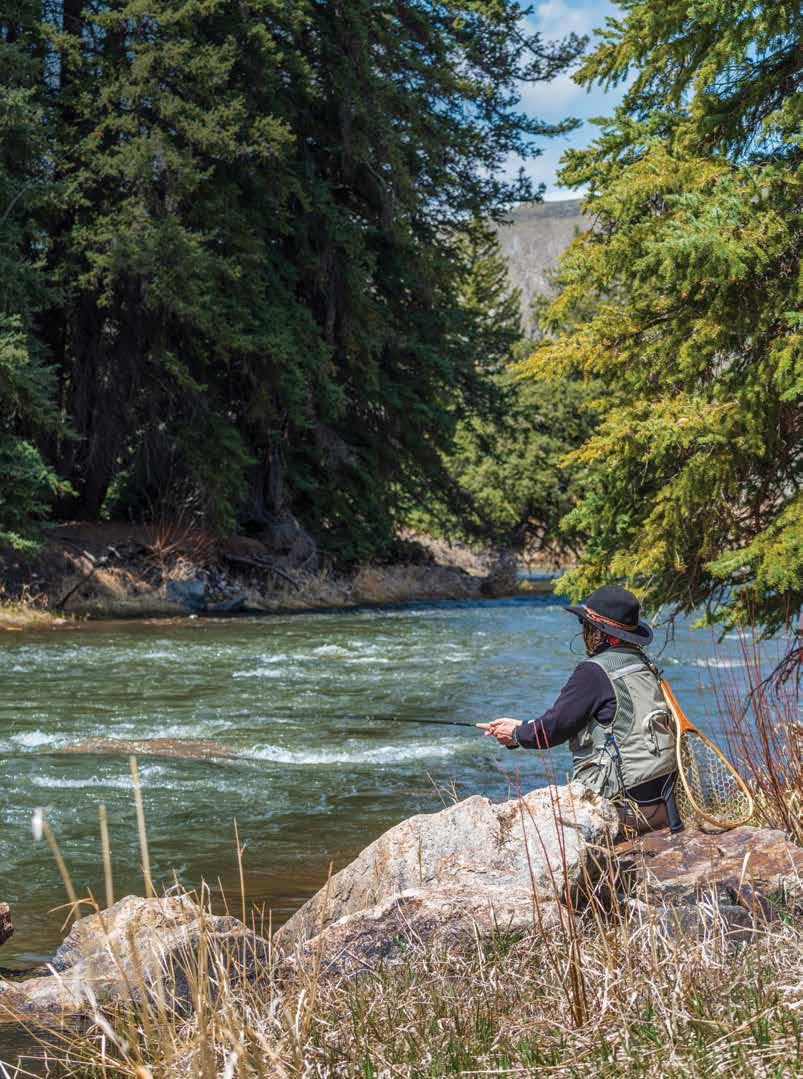
Secure your financial future and the future of wild and native trout and salmon. A Charitable Gift Annuity provides peace of mind with regular fixed payments during your lifetime and ensure future generations can know the joy of a cold running stream. NEW – If you are 70½ or older, you can now transfer up to $50,000 from your IRA to acquire a charitable gift annuity. Contact Sue Thomas at (703) 284-9421 or Legacy@TU.org to learn more about these and other gifts that benefit both you AND Trout Unlimited.
RIO Products
Idaho Falls, ID 83402 (800) 553-0838
rio@rioproducts.com www.rioproducts.com
RIVHAB Engineering Design
Jeanne McFall Eagle, ID 83616 (208) 401-6129 jeanne@rivhab.net www.rivhab.net
Silver Creek Outfitters
Terry Ring Ketchum, ID 83340 (208) 726-5282 office@silver-creek.com www.silver-creek.com
South Fork Lodge & Outfitters
Zach Peyton / Guide Manager Swan Valley, ID 83449 (208) 483-2112 fish@southforklodge.com www.southforklodge.com
Tight Line Media
Kris Millgate Idaho Falls, ID 83405-0242 (208) 709-0309 kris@tightlinemedia.com www.tightlinemedia.com
GOLD LEVEL
WorldCast Anglers
Mike Dawkins Victor, ID 83455 (800) 654-0676 gofish@worldcastanglers.com www.worldcastanglers.com
ILLINOIS
GetOut Networking
Spencer Kaehler Winnetka, IL 60093 spencer@getout.network www.getout.network
IOWA
Pescador on the Fly
Jeff Ditsworth West Des Moines, IA 50266 (515) 240-6774 info@pescadoronthefly.com www.pescadoronthefly.com
Trout Buddy Driftless Guides
Mike Warren Cross Plains, WI 53528 (608) 792-2521 mjw54601@icloud.com www.TroutBuddy.com
Wilderness Lite LLC
Phillip Hayes Maurice, IA 51036 wildernesslite@gmail.com www.wildernesslitefloattubes.com
KANSAS
Great Blue Heron Outdoors
Robert Marsh Lawrence, KS 66044 (785) 856-5656 info@gbh-outdoors.com www.greatblueheronoutdoors.com
MAINE
Appalachian Mountain Club
Maine Wilderness Lodges
Jenny Ward Greenville, ME 04441 (207) 695-3085 jward@outdoors.org www.outdoors.org
Chandler Lake Camps and Lodge
Jason and Sherry Bouchard
North Maine Woods, ME 04732 (207) 731-8938 info@chandlerlakecamps.com www.chandlerlakecamps.com
HMH Vises
Jon Larrabee Biddeford, ME 04005 T: (207) 729-5200 F: (207) 729-5292 jon@hmhvises.com www.hmhvises.com
Sam Lambert Keller Williams Realty Brunswick, ME 04011 (207) 522-7728 samlambertrealestate@gmail.com
L.L.Bean Inc. Mac McKeever Freeport, ME 04033-0002 (207) 865-4761 www.llbean.com
Rangeley Region Sports Shop
Brett Damm Rangeley, ME 04970 (207) 864-5615 rangeleyflyshop@gmail.com www.rangeleyflyshop.com
Western Maine Yurts, Inc Bethel, ME 04217 stay@westernmaineyurts.com stay@westernmaineyurts.com
Boatyard Bar & Grill
Dick Franyo Annapolis, MD 21403 (410) 267-0145 dick@boatyardbarandgrill.com www.boatyardbarandgrill.com
Rich Dennison Fly Fishing
Rich Dennison Parkville, MD 21234 (443) 668-3535 richdennisonflyfishing@gmail.com www.richdennisonflyfishing.com
Ecotone, Inc. Scott McGill Forest Hill, MD 21050 (410) 420-2600 chall@ecotoneinc.com www.ecotoneinc.com
Resource Restoration Group, LLC Tracys Landing, MD 20779 info@rrgroup.us www.rrgroup.us
Savage River Lodge
Mike Dreisbach Frostburg, MD 21532 (301) 689-3200 mike@savageriverlodge.com www.savageriverlodge.com
MASSACHUSETTS
Cheeky Fishiing
Ted Upton (339) 707-3017 North Adams, MA 01247 getcheeky@cheekyfishing.com www.cheekyfishing.com
High Hook Oregon Wines
T. Mark Seymour Leverett, MA 01054 (413) 218-0638 mark@fishhookvineyards.com www.fishhookvineyards.com
Krag Silversmith
Wendy O’Neil
Stockbridge, MA 01262 wendy@kragsilversmith.com www.kragsilversmith.com
Postfly
Brian Runnals
Newbury, MA 01951 brian@postflybox.com www.postflybox.com
Recur Outdoors, Inc.
Brian Runnals Newbury, MA 01951 brunnals@recuroutdoors.com www.recuroutdoors.com
Swift River Fly Fishing
Rick Taupier
New Salem, MA 01355 (413) 230-1262 swiftriverflyfishing@earthlink.com www.swiftriverflyfishing.com
Vedavoo
Scott Hunter Lancaster, MA 01523 (307) 399-0780 campfire@vedavoo.com www.vedavoo.com
Wild Soul River, LLC
Justin Adkins Williamstown, MA 01267 (413) 597-1172 info@wildsoulriver.com www. wildsoulriver.com
Wingo Outdoors Ted Upton (339) 707-3017 North Adams, MA 01247 info@wingooutdoors.com www.wingooutdoors.com
The Wooden Fly Bart Estes Easthampton, MA 01027 (413) 588-1125 bartestes42@yahoo.com www.etsy.com/shop/TheWoodenFly
MICHIGAN
Au Sable River Guide Service
Captain Tom Quail Lake Orion, MI 48360 (248) 495-2615 ausableriverguideservice@gmail. com www.ausableriverguideservice.com
CastBack
Justin Sivils Saline, MI 48176 angler-j@castback.com www.castback.com
Diem Investments, Inc. Grand Rapids, MI 49503
The Gremel Group Andrew Gremel Belmont, MI 49306 (616) 874-2200 andy@gremelgroup.com www.gremelgroup.com
HFF Custom Rods Steven Haywood Taylor, MI 48180 stevenh@hffcustomrods.com www.hffcustomrods.com
HomeWaters Real Estate
Chad Brown Traverse City, MI 49686 (231) 258-5309 chad@homewaters.net www.homewaters.net
Indigo Guide Service
Kevin Morlock Branch, MI 49402 (231) 613-5099 indigoguidekevin@gmail.com www.indigoguideservice.com
J. A. Henry Rod and Reel Company Andrew Mitchell Rockford, MI 49341 j.a.henryusa@gmail.com www.jahenryusa.com
MothBear Outfitters Tylor Witulski Alpena, MI 49707 (989) 884-3288 www.mothbear.com support@mothbear.com
North Rivers Lodge Joe Neumann Luther, MI 49656 (231) 266-6014 northriverslodge@gmail.com www.northriverslodge.com
Northern Lights Guide Service
John and Trish Kluesing Baldwin, MI 49304 (231) 745-3792 jtkluesing@gmail.com
Oshki
Jackson Riegler Muskegon, MI 49441 (231) 955-1392 jackson@oshki.us www.oshki.us
PM Trailhead Lodge
Bonnie Price Baldwin, MI 49304 (810) 247-0972 pmtrailheadlodge@gmail.com www.pmtrailheadlodge.com
Pere Marquette River Lodge Frank Willetts Baldwin, MI 49304 (231) 745-3972 staff@pmlodge.com www.pmlodge.com
Red Moose Lodge Cast Away Guide Service Clint and Debi Anderson Baldwin, MI 49304 (231) 745-6667 info@redmooselodge.com www.redmooselodge.com www.castawayguideservice.com
Salmo Java Roasters Fred Taber Kalamazoo, MI 49048 (269) 806-6829 salmojava@gmail.com https://salmojavaroasters.com/ Upper Peninsula Concrete Pipe Co. Craig Vanderstelt Escanaba, MI 49829 (906) 786-0934 cvanderstelt@upconcretepipe.net www.upconcretepipe.net
The Driftless Fly Fishing Company Melvin Hayner Preston, MN, 55965-1096 (507) 765-4915 melvin@minnesotaflyfishing.com www.minnesotaflyfishing.com
Namebini
Carl Haensel and Jade Thomason Duluth, MN 55804 (218) 525-2381 info@namebini.com www.namebini.com
Rose Creek Anglers Rich Femling Roseville, MN 55113 (763) 807-5878 rich@rose-creek.com www.rose-creek.com
Solid Rock Masonry Eric Moshier Duluth, MN 55803 (218) 343-2978 info@solidrockmasonry.com www.solidrockmasonry.com
Trout Buddy Driftless Guides
Mike Warren La Crosse, WI 54601 (608) 792-2521 mjw54601@icloud.com www.TroutBuddy.com
TroutRoutes
Erik Johnsen Minneapolis, MN 55413 ejohnsen@troutroutes.com www.troutroutes.com
Bob White Studio
Bob White Marine on Saint Croix, MN 55047 (651) 433-4168 bob@bobwhitestudio.com www.bobwhitestudio.com
MISSOURI
Jim Rogers Fly Fishing School
Jim Rogers Lebanon, MO 65536 (417) 532-4307 ext. 2 www.jimrogersflyfishing.com
MONTANA
Alphagraphics Missoula
Troy Peissig Missoula, MT 59801 tpeissig@alphagraphics.com www.alphagraphics.com
Alpine Foot and Ankle Clinic Dr. Gregg Neibauer Missoula, MT 59801 (406) 721-4007 www.alpinefoot.com
Angler's West Fly Fishing Outfitters
Matson Rogers Emigrant, MT 59027 (406) 333-4401 info@montanaflyfishers.com www.montanaflyfishers.com
Dan Bailey’s Outdoor Company
Dale Sexton Livingston, MT 59047 (406) 222-1673 info@danbaileys.com www.danbaileys.com
Beartooth Flyfishing
Dan and Nancy Delekta Cameron, MT 59720 (406) 682-7525 info@beartoothflyfishing.com www.beartoothflyfishing.com
Big Hole Lodge
Craig Fellin Wise River, MT 59762 (406) 832-3252 info@bigholelodge.com www.bigholelodge.com
Bighorn Fly and Tackle Shop
Duane Schreiner Fort Smith, MT 59035 (888) 665-1321 bighornfly@gmail.com www.bighornfly.com
Big Sky Anglers
Justin Spence West Yellowstone, MT 59758 (406) 646-7801 info@bigskyanglers.com www.bigskyanglers.com
GOLD LEVEL
Blackfoot River Outfitters, Inc.
John Herzer and Terri Raugland Missoula, MT 59808 (406) 542-7411 trout@blackfootriver.com www.blackfootriver.com
Casting for Recovery, Inc. Faye Nelson Bozeman, MT 59715 (406) 624-6583 www.castingforrecovery.org info@castingforrecovery.org
CrossCurrents Fly Shop
Chris Strainer Helena, MT 59601 (406) 449-2292 crosscurrentsflyshop@gmail.com www.crosscurrents.com
ERA Landmark Real Estate Kelly Bresnahan Bozeman, MT 59715 (406) 586-1321 kelly@eralandmark.com www.eralandmark.com
Fay Ranches
Greg Fay Bozeman, MT 59715 406-586-4001 info@fayranches.com www.fayranches.com
Flint Creek Outdoors
Matthew Churchman Philipsburg, MT 59858 (406) 859-9500 matthew@blackfootriver.com www.flintcreekcoutdoors.com
Gallatin River Guides
Mike Donaldson Big Sky, MT 59716 (406) 995-2290 gallatinriverguides@gmail.com www.montanaflyfishing.com
Gallatin River Lodge
Steve Gamble Bozeman, MT 59718 (888) 387-0148 sgamble@grlodge.com www.grlodge.com
Glacier Anglers
Mike Cooney West Glacier, MT 59936 (406) 888-5454 info@glacierraftco.com www.glacieranglers.net
GOLD LEVEL
Healing Waters Lodge
Mike and Laura Geary Twin Bridges, MT 59754 (406) 684-5960 hwlodge@gmail.com www.hwlodge.com


Hubbard’s Yellowstone Lodge
Nancy Hubbard Emigrant, MT 59027 (406) 848-7755 nancy@hubya.com www.hubbardslodge.com
Lakestream Fly Shop
Whitefish, MT 59937 info@lakestream.com www.lakestreamflyshop.com
GOLD LEVEL
Linehan Outfitting Company
Tim Linehan Troy, MT 59935 (800) 596-0034 info@fishmontana.com www.fishmontana.com
Long Outfitting
Matthew A. Long Livingston, MT 59047 (406) 220-6775
info@longoutfitting.com www.longoutfitting.com
Madison Valley Ranch, LLC
Manu Redmond Ennis, MT 59729 (800) 891-6158 mvr@3rivers.net www.madisonvalleyranch.com
LV Wood
James and Tara Caroll Bozeman, MT 59715 (406) 624-7273 west@lvwood.com www.lvwood.com
Denny Menholt Honda
Matt Smith Bozeman, MT 59718 (406) 587-0761 matts@dennymenholthonda.com www.dennymenholthonda.com
Montana Angler Fly Fishing Brian McGeehan Bozeman, MT 59718 (406) 522-9854 business (406) 570-0453 cell brian@montanaangler.com www.montanaangler.com
Montana Angling Company Max Yzaguirre Bozeman, MT 59715 (406) 579-9553 info@montanaanglingco.com www.montanaanglingco.com
Montana Fishing Outfitters
Garrett Munson Helena, MT 59601 (406) 431-5089 heymfo@montanafishingoutfitters.com www.montanafishingoutfitters.com
Montana Fly Company
Jake Chutz Columbia Falls, MT 59912 (406) 892-9112 jake@montanafly.com www.montanafly.com
Montana Fly Fishing Lodge
Montana Trout Stalkers
Joe Dilschneider Ennis, MT 59729 (406) 581-5150 joe@montanatrout.com www.montanatrout.com
Parks’ Fly Shop
Kody Marr Gardiner, MT 59030 kody@parksflyshop.com www.parksflyshop.com
P3 Properties
Patrick Pozzi Missoula, MT 59808 pozzi.patrick@gmail.com
PRO Outfitters
Brandon Boedecker Helena, MT 59624 (406) 442-5489 pro@prooutfitters.com www.prooutfitters.com
Realty ONE Group Peak
Bryan Atwell Bozeman, MT 59715 (406) 579-7616 bryan@bryanatwell.com www.bozemanrealtyone.com
The River’s Edge
Royal Bighorn Club
Dan Vermillion Livingston, MT 59047 (888) 347-4286 dan@sweetwatertravel.com www.sweetwatertravel.com
Ruby Springs Lodge Paul Moseley Sheridan, MT 59749 (406) 842-5250 info@rubyspringslodge.com www.rubyspringslodge.com
Dan Rust State Farm Insurance
Dan Rust Bozeman, MT 59715 (406) 587-8287 dan.rust.b60w@statefarm.com
Simms
Diane Bristol Bozeman, MT 59718 (406) 585-3557 info@simms.com www.simmsfishing.com
Stockman Bank – Bozeman Paul Pahut Bozeman, MT 59718 (406) 556-4100 paul.pahut@stockmanbank.com www.stockmanbank.com
Sweetwater Travel Company
Dan, Jeff & Pat Vermillion Livingston, MT 59047 (888) 347-4286 dan@sweetwatertravel.com www.sweetwatertravel.com
TicketPrinting.com
Lance Trebesch Bozeman, MT 59715 (888) 771-0809 support@ticketprinting.com www.ticketprinting.com Toyota of Bozeman Jayden Schaap Bozeman, MT 59718 (406) 551-6642 marketing@resslermotors.com www.toyotaofbozemancom
Trail Head & Trail Head River
Sports
Todd Frank Missoula, MT 59807 (406)543-6966 tfrank@trailheadmontana.net www.trailheadmontana.net
Triple-M-Outfitters
TroutRoutes
Zachary Pope Columbia Heights, MN 55421 (612) 965-8039 zpope@troutinsights.com www.troutinsights.com
Trout Scapes River Restoration, LLC Brian Cowden Bozeman, MT 59715 (201) 230-3383 bcowden@troutscapes.com www.troutscapes.com
Trout Tales Fly Fishing Ian Secrest Bozeman, MT 59718 (406)539-4327 ian@trouttalesflyfishing.com www.trouttalesflyfishing.com
Wild Montana Anglers Mark Fuller Martin City, MT 59926 (406) 261-4343 mark@wildmontanaanglers.com www.wildmontanaanglers.com
Stockman Bank – Missoula
Yellow Dog Flyfishing Adventures, LLC Bozeman, MT 59715-4630 (406) 585-8667 info@yellowdogflyfishing.com www.yellowdogflyfishing.com Make 2025 the year you
Lincoln Powers Billings, MT 59106 (406) 780-0015 info@montanaflyfishinglodge.com www.montanaflyfishinglodge.com
Dan Lohmiller Bozeman, MT 59715 (406) 586-5373 info@theriversedge.com www.theriversedge.com
The River’s Edge West
Dan Lohmiller Bozeman, MT 59718 (406) 284-2401 info@theriversedgewest.com www.theriversedge.com
Bob Burns Missoula, MT 59801 (406) 258-1401 bburns@stockmanbank.com www.stockmanbank.com
Mark Faroni Dixon, MT 59831 (406) 246-3249 mark@triplemoutfitters.com www.triplemoutfitters.com
Trout On The Fly
Nate Stevane Outfitter #8533 Bozeman, MT 59718 (406) 580-7370 nate@montanatroutonthefly.com www.montanatroutonthefly.com
Wild Trout Outfitters, Inc. J.D. Bingman Big Sky, MT 59716 (406) 995-2975 fish@wildtroutoutfitters.com www.wildtroutoutfitters.com
Yellowstone Fly Fishing Co.
James Pappas Livingston, MT 59047
yellowstonefishingco@gmail.com www.yellowstoneflyfishingco.com
Yellowstone River Outfitters
Brogan Ballard Livingston, MT 59047 (406) 531-1838
yellowstoneriveroutfitters@gmail.com www.yellowstoneriveroutfitters.com
Outlaw Rod Company
Anthony Saling Sparks, NV 89431 (775) 636-2945 anthony_saling@yahoo.com www.outlawrodco.com
American Fly Outfitters
Dan Tilton Winham, NH 03087
info@americanflyoutiffters.com
www.americanflyoutfitters.com
Hobbs Brewing Company Ossipee, NH 03814 (603) 539-3795
info@hobbsbeer.com www.hobbsbeer.com
Lopstick
Roderick DeGreef Pittsburg, NH 03592 rod@lopstick.com www.lopstick.com
Schilling Beer Company
Jeff Cozzens Littleton, NH 03561 (603) 444-4800
jeff@schillingbeer.com www.schillingbeer.com
Stone River Outfitters
1 State Route 101A, Unit 1 Amherst, NH 03031 (603) 472-3191 (800) 331-8558 sales@stoneriveroutfitters.com www.stoneriveroutfitters.com
Keystone Reclamation Fuel Management LLC
Morristown, NJ 07960
oakpool
Alex Ford Jersey City, NJ 07302 (908) 642-8930 alex@fordhamilton.com www.oakpool.xyz
Ramsey Outdoor
Marty Brennan Succasunna, NJ 07876 (973) 584-7798
mbrennan@ramseyoutdoor.com www.ramseyoutdoor.com
RoxStar Fishing
Mike James Howell, New Jersey 07731 (973) 704-1323
mike@roxstarfishing.com www.roxstarfishing.com
Suburban Fly Fishers
Tim Glynn Maplewood, NJ 07040 (973) 220-3031
timothyglynn@verizon.net www.suburbanflyfishers.com
Tightline Productions Tim and Joan Flagler Califon, NJ 07830 (908) 832-6677
tightlineproductions@comcast.net www.tightlinevideo.com
Chama Trails Motel
Austin and Karlee Phippen Chama, NM 87520 (575) 756-2156 chamatrails@windstream.net www.chamatrailsmotel.com
Fly Fishing Outpost Santa Fe, NM 87506 (505) 629-5688 trout@loeflyfishing.com www.flyfishingoutpost.com Land of Enchantment Guides
Noah Parker Velarde, NM 87582 (505) 629-5688 trout@loeflyfishing.com www.loeflyfishing.com
Steve Lynch Wealth Management
Stephen Lynch Albuquerque, NM 87110 (505) 881-7526 stephenclynch@aol.com www.stevelynchwealth.com
Questa Economic Development Fund
Lindsay Mapes (575) 586-2149 lindsay@questaedf.com
Rezo Systems
Marc Harell Taos, NM 87571 (505) 603-1342 info@rezosystems.com www.rezosystems.com
Rocky MTN Tenkara
Casey Canfield Rio Rancho, New Mexico 87124 (505) 252-1667 contact@rockymtntenkara.com www.rockymtntenkara.com
A. Rubey Rod Company
Andy Rubey Corrales, NM 87048 (614) 546-7828 andy@rubeyrods.com www.rubeyrods.com
Sitzmark Sports & Lodge Payton Martinez Red River, NM 87558 payton@sitzmarknm.com www.sitzmarknm.com
GOLD LEVEL
Taos Fly Shop
Nick Streit Taos, NM 87571 (575) 751-1312 info@taosflyshop.com www.taosflyshop.com
NEW YORK
Black Dog Outdoor Sports
Target Sports
Steve Borst Glenville, New York 12302 (518) 355-8923 www.blackdogsports.com
Douglas Outdoors
David Barclay Phoenix, NY 13135 (315) 695-2000 info@douglasoutdoors.com www.douglasoutdoors.com
Evans Group Global Real Estate
Asset Management Trust
Emmet Evans New York, NY 10021
Fly on the Water Allen Rupp New York, NY 10023 (872) 205-9211 allen@flyonthewater.com www.flyonthewater.com
Fly Shack, Inc.
Michael Bokan Gloversville, NY 12078 (800) 801-2318 info@flyshack.com www.flyshack.com
High Peaks Adirondack Outfitters
Brian and Karen Delaney Lake Placid, NY 12946 (518) 532-3764 info@highpeakscyclery.com www.highpeakscyclery.com
Orvis Retail Store - Rochester
Jim Wallace Rochester, NY 14618 (585) 586-3956
Retail-rochestermgr697@orvis.com www.orvis.com/rochester
Tailwater Lodge
Brian Benner Altmar, NY 13302 (315) 298-3435
bbenner@tailwaterlodge.com www.tailwaterlodge.com
West Kill Brewing
Michael Barcone West Kill, NY 12492 info@westkillbrewing.com www.westkillbrewing.com
Brookings Anglers
Matt Canter Cashiers, NC 28717 (828) 743-3768 info@brookingsonline.com www.brookingsonline.com
Chosen River Outfitters
David Stelling Banner Elk, NC 28604 highcountryguides@gmail.com www.flyfishthehighcountry.com
Coastal Cottages
Mark Milby Kitty Hawk, NC 27949 obxcottageplans@gmail.com
Creel Lodge at Middle Creek
Keith Foster Otto, NC 28763
keith@creellodge.com www.creellodge.com
Headwaters Outfitters
Jessica Whitmire Rosman, NC 28772 (828) 877-3106
jessica@headwatersoutfitters.com www.headwatersoutfitters.com
Hunter Banks Company
Frank Smith Asheville, NC 28801 (828) 252-3005 staff@hunterbanks.com www.hunterbanks.com
Nantahala River Lodge
Mickey and Annette Youmans Topton, NC 28781 (912) 596-4360 (800) 470-4718 mickey@nantahalariverlodge.net www.nantahalariverlodge.net
Pesca Muerta
Winston Salem, NC 27104 (336) 355-4561 info@pescamuerta.com www.pescamuerta.com
Pisgah Outdoors
Heath Cartee Pisgah Forest, NC 28768 (828) 577-3277 heath@pisgahoutdoors.com www.pisgahoutdoors.com
SWCA
Kyle Halchin Charlotte, NC 28205 kylehalchin@gmail.com www.swca.com
Whitetail Fly Tieing Supplies
Nancy Richardson Chapel Hill, NC 27516 (630) 294-2947 nancy.richardson55@gmail.com www.whitetailflytieing.com
OHIO
Time Timer, LLC
David Rogers Cincinnati, OH 45243 (877) 771-8463 dave@timetimer.com www.timetimer.com
OKLAHOMA
K R Parker Holdings, LLC
Ken Parker Tulsa, OK 74137 krprkr@gmail.com
OREGON
Alpine Archery and Fly
John Appleton La Grande, OR 97850 (541) 963-4671 alpinearcheryllc@gmail.com www.alpinearcheryandfly.com
GOLD LEVEL
The Caddis Fly Angling Shop
Chris Daughters Eugene, OR 97401 (541) 505-8061 caddiseug@yahoo.com www.caddisflyshop.com
Creative Resource Strategies, LLC
Lisa DeBruyckere Salem, OR 97317 (503) 371-5939 lisad@createstrat.com www.createstrat.com
The Fly Fishing Shop
Mark Bachmann Welches, OR 97067 (503) 781-6468 flyfish@flyfishusa.com www.flyfishusa.com
The Fly Fishing Place
Nick Nickens Summerville, OR 97876 editors@theflyfishingplace.com www.theflyfishingplace.com
Fly Water Travel Ashland, OR 97520 (800) 552-2729 info@flywatertravel.com www.flywatertravel.com
Loon Outdoors
Brett Zundel
Alan Peterson
Ashland, OR 97520 (800) 580-3811 service@loonoutdoors.com www.loonoutdoors.us
Minam Store Outfitters
Grant Richie Wallowa, OR 97885 (541) 431-1111 grant.minam@gmail.com www.minamstore.com
Paul’s Pipes
Paul Menard Bend, OR 97703 info@paulspipes.com www.paulspipes.com
The Rogue Angler
Mark Koenig Eugene, OR 97402 (800) 949-5163 customerservice@therogueangler.com www.therogueangler.com
Royal Treatment Fly Fishing
Joel La Follette West Linn, OR 97068 (503) 850-4397 joel@royaltreatmentflyfishing.com www.royaltreatmentflyfishing.com
Sawyer Paddles and Oars
Zac Kauffman Gold Hill, OR 97525 (541) 535-3606 zac@paddlesandoars.com www.paddlesandoars.com
ARIPPA
Jaret Gibbons & Cristy Sweeney Camp Hill, PA 17011 (717) 763-7635 jgibbons@arippa.org csweeney@arippa.org www.arippa.org
Arnot Sportsmen’s Assoc., Inc
Ron Signor Arnot, PA 16911 (570) 638-2985 sms2333@PTD.NET
Creamton Fly Fishing Club Bethlehem, PA 18015 jms1701@gmail.com www.creamtonflyfishingclub.com
Cross Current Guide Service and Outfitters
Joe Demalderis Starlight, PA 18461 (914) 475-6779 crosscurrent@optonline.net www.crosscurrentguideservice.com
Drop Tine Taxidermy LLC Mason Farnell Albrightsville, PA 18210 (570) 983-4054 droptinepa@outlook.com
The Fly Fishing Show Ben Furimsky Somerset, PA 15501 (814) 443-3638 ben@flyfishingshow.com www.flyfishingshow.com Flyway Excavating, Inc. Brad Clubb Mount Joy, PA 17552 (717) 560-0731 bclubb@flywayexcavating.com www.flywayexcavating.com
The Forest Lake Club
Colleen Van Horn Hawley, PA 18428 (570) 685-7171 gm@forestlakeclub.net www. forestlakeclub.net
Gleim Environmental Group
Stephanie Rider Carlisle, PA 17013 (717) 258-4630 srider@jwgleim.com www.jwgleim.com
Jim’s Sports Center Terry Malloy Clearfield, PA 16830 (814) 765-3582 terry@jimssports.com www.jimssports.com
Gorski Engineering Jerry Gorski Collegeville, PA 19426 (610) 489-9131 jgorski@gorskiengineering.com www.gorskiengineering.com
The Lodge at Glendorn Shane Appleby Bradford, PA 16701 (814) 362-6511 sappleby@glendorn.com www.glendorn.com
The Lodge at Woodloch Josh Heath Hawley, PA 18428 (800) 966-3562 jheath@thelodgeatwoodloch.com www.thelodgeatwoodloch.com
Milestone Financial Associates
David S. Coult, CFP® Macungie, PA 18062 (610) 421-8777 dcoult@milestonefa.com www.milestonefa.com
PA Fly Company Doug Yocabet Mount Pleasant, PA 15666 (724) 322-0037 doug@paflyco.net www.paflyco.net
PA Troutfitters
Bill Nolan Slatedale, PA 18079 (717) 875-7426 patroutfitters@gmail.com www.patroutfitters.fish
Papillon & Moyer Excavating & Paving, LLC
Dave Moyer Stroudsburg, PA 18360 (570) 421-5020 dave.moyer@papillon-moyer.com www.papillon-moyer.com
Perfect Hatch Fly Fishing Tony Grubb Lansdale, PA 19446 (800) 523-6644 tony@rayrumpf.com www.perfecthatch.com
GOLD LEVEL Pride of Bristol Bay
Steve and Jenn Kurian Bloomsburg, PA 17815 (570) 317-2200 contact@prideofbristolbay.com www.prideofbristolbay.com
Robindale Energy Services, Inc. James Panaro Ebensburg, PA 15931 (814) 322-2294 jim.panaro@resfuel.com www.robindale.energy
GOLD LEVEL
Sky Blue Outfitters
Rick Nyles Fleetwood, PA 19522 (610) 987-0073 rick@skyblueoutfitters.com www.skyblueoutfitters.com
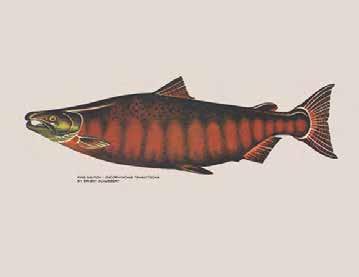

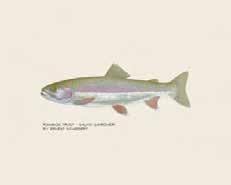
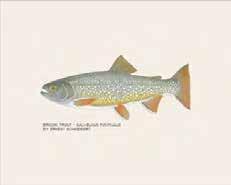

With your purchase - you are making a difference! We are now offering Salmon and Trout Prints. All proceeds from the sale of these prints will go directly towards the Chapters mission of protecting our streams, conservation programs that engage the community, and sponsoring angler-based organizations like Heroes On The Water and Casting for Recovery. Prints can be viewed in person at Bowman's Tavern and Restaurant 1600 River Rd., New Hope, Pa 18938. Thank You!

That Fish Place-That Pet Place
Stephanie Welsh Lancaster, PA 17603 (717) 345-4671
swelsh@thatpetplace.com
www.thatpetplace.com
Thomas Spinning Lures, Inc.
Peter Ridd Hawley, PA 18428 (800) 724-6768 info@thomaslures.com www.thomaslures.com
Wild East Outfitters
Nick Raftas Coatesville, PA 19320 (610) 500-3147
wildeastoutfitters@outlook.com www.wildeastoutfitters.com
Wild for Salmon
Steve Kurian Bloomsburg, PA 17815 (570) 387-0550 info@wildforsalmon.com www.wildforsalmon.com
Dodson Fishing Company
Drew Malone Travelers Rest, SC 29651 (864) 704-4658 info@dodsonfishing.com www.dodsonfishing.com
Fenwick
Jim Murphy Columbia, SC 29203 (800) 334-9105 info@purefishing.com www.purefishing.com
Hardy Fly Fishing
Jim Murphy Columbia, SC 29203 (800) 334-9105 info@purefishing.com www.purefishing.com
Hellbender Nets
Bailly & JD Wagner Easley, SC 29640 hellbendernets@gmail.com www.hellbendernets.com
Jocassee Outfitters Fly Shop
Kevin Clinton Salem, SC 29676
kevin@Jocasseeoutfitters.com www.jocasseeoutfitters.com
The Lodge at Green Cove Green Angler Store
Jason McConkey Tellico Plains, TN 37385 (423) 252-4014 greencoveangler@gmail.com www.greencoveangler.com
Smoky Mountain Angler
Harold Thompson Gatlinburg, TN 37738 (865) 436-8746 info@smokymountainangler.com www.smokymountainangler.com
Smoky Mountain Spinnery
Frederick Thompson Gatlinburg, TN 37738
nancy@smokymountainspinnery.com www.smokymountainspinnery.com
Action Angler
Chris Jackson
New Braunfels, TX 78132 (830) 708-3474
info@actionangler.net www.actionangler.net
Castell Guide Service
Dan Cone
Round Rock, TX 78130 (325) 423-0045
info@castellguideservice.com www.castellguideservice.com
GOLD LEVEL
Gruene Outfitters
Tiffany Yeates
New Braunfels, TX 78130 (830) 660-4400
tiffany@grueneoutfitters.com www.gueneoutfitters.com
HB Systems Inc.
Corey Allen Plano, TX 75023 www.hbsystemsinc.com
GOLD LEVEL
Living Waters Fly Fishing Round Rock, TX 78664 (512) 828-3474
chris@livingwatersflyfishing.com www.livingwatersflyfishing.com
Yeti Coolers
Jake Drees Austin, TX 78735 (512) 394-9384 info@yeti.com www.yeti.com
UTAH
Headwaters Bamboo
David Rogers Washington, UT 84780 (208)789-4391 david@headwatersbamboo.com www.headwatersbamboo.com
Park City Outfitters
Brandon Bertagnole Park City, UT 84098 (866) 649-3337 bbertagnole@hotmail.com www.parkcityoutfitters.com
Utah Whitewater Gear
Clinton Monson Midvale, UT 84047 clinton@utahwhitewatergear.com www.utahwhitewatergear.com
VERMONT
Three Rivers Equine Veterinary Service
Tyler McGill Barnet, VT 05821 tmcgillvt@gmail.com www.threeriversequinevet.com
VIRGINIA
Atlantic Bulk Carrier Corporation
Mark Short Providence Forge, VA 23140 mshort@atlanticbulk.com www.atlanticbulk.com beag+haus | creative + modern small home design
Marc O'Grady Ashburn, VA 20147 (888) 984-1853 contact@beaghaus.com www.beaghaus.com
Beaverdam Falls, LLC Beau Bryan Covington, VA 24426 info@beaverdamfalls.com www.beaverdamfalls.com
Ecosystem Services, LLC Kip Mumaw Charlottesville, VA 22903 (540) 239-1428 kip@ecosystemservices.us www.ecosystemservices.us
Hutton Fly Expeditionary
Fly Fishing Travel
Derek Hutton Lexington, VA 24450 (208) 399-1888 info@huttonfly.com www.huttonfly.com
Interior Federal Credit Union Washington, DC 20240 Reston, VA 20192 (800) 914-8619 www.interiorfcu.org
GOLD LEVEL
Mossy Creek Fly Fishing
Colby Trow Harrisonburg, VA 22801 (540) 434-2444
store@mossycreekflyfishing.com www.mossycreekflyfishing.com/ Potts Creek Outfitters
Daniel Walsh Paint Bank, VA 24131 (540) 897-5555 pco@pottscreekoutfitters.com www.pottscreekoutfitters.com
South River Fly Shop
Tommy Lawhorne
Kevin Little Waynesboro, VA 22980 (540) 942-5566 shop@southriverflyshop.com southriverflyshop.com
Stonegate–An Elegant Guest House
Margaret Hutton Lexington, VA 24450 (208) 399-1887 hutton@stonegatevirginia.com www. stonegatevirginia.com
Virginia River Guides
Derek Hutton Lexington, VA 24450 (208) 399-1888 trips@VirginiaRiverGuides.com www.VirginiaRiverGuides.com
WASHINGTON
DRYFT
Sam Thompson and Nick Satushek Bellingham, WA 98229 (360) 818- 4047 contact@dryftfishing.com www.dryftfishing.com
Grundens Poulsbo, WA 98370 (800) 323-7327 support@grundens.com www.grundens.com
Redington
Bainbridge Island, WA 98110 (800) 253-2538 info@redington.com www.redington.com
Red’s Fly Shop
Joe Rotter Ellensburg, WA 98926 (509) 933-2300
staff@redsflyshop.com www.redsflyshop.com
Sage Fly Fishing
Bainbridge Island, WA 98110 (206) 842-6608 (800) 553-3004
sage@sageflyfish.com www.sageflyfish.com
Silver Bow Fly Fishing
Sean Visintainer Spokane Valley, WA 99216 (509) 924-9998 flyfish@silverbowflyshop.com www.silverbowflyshop.com
Angler’s Xstream Parkersburg, WV 26101 (877) 909-6911
fishing@anglersxstream.com www.anglersxstream.com
Fife Street Brewing
Josh Dodd Charleston, WV 25302 (304) 941-8269 josh@fifestreetbrewing.com www.fifestreetbrewing.com
WISCONSIN
Alongi Santas Insurance Agency, Inc. Mark Santas Beloit, WI 53511 www.alongiinsurance.com
Lund's Fly Shop
Brian Smolinski River Falls, WI 54022 (715) 425-2415 brian@lundsflyshop.com www.lundsflyshop.com
Trout Buddy Driftless Guides
Mike Warren La Crosse, WI 54601 (608) 792-2521 Mike@TroutBuddy.com www.TroutBuddy.com
Arrow Land and Water, LLC
Chad Espenscheid Big Piney, WY 83113 (307) 231-2389 chadespen@gmail.com
Bighorn Drifters
Dean Schaff Lander, WY 82520 (307) 349-9573 307BHDrifter@gmail.com www.bighorndrifters.com
Dunoir Fishing Adventures, LLC
Jeramie Prine Lander, WY 82520 (307) 349-3331 jlprine@gmail.com www.dunoirfishing.com
Fish the Fly Guide Service & Travel
Jason Balogh Jackson, WY 83001 (307) 690-1139 jb@fishthefly.com www.fishthefly.com
Grand Teton Fly Fishing
Scott Smith and Mark Fuller Jackson, WY 83002 307-690-4347 ssflyfish@rocketmail.com markwfuller@gmail.com www.grandtetonflyfishing.com
Graylight Outfitters
David Collom Elsinore, UT 84724 (435) 720-7440 graylightoutfitters@gmail.com www.graylightoutfitters.com
JD High Country Outfitters Jackson, WY 83001 (307) 733-7210 scott@jdhcoutfitters.com www.highcountryflies.com
Koyoty Sports Warden Patzer Saratoga, WY 82331 Trophyroomtaxi@yahoo.com www.koyotysports.com
Live Water Properties
Macye Maher Jackson, WY 83002 (866) 734-6100 macye@livewaterproperties.com www.livewaterproperties.com
North Fork Anglers
Blair Van Antwerp Cody, WY 82414 (307) 527-7274 flyfish@wavecom.net www.northforkanglers.com
Park County Glass Cody, WY 82414 (307) 587-9303 pcg@bresnan.net www.parkcountyglass.com
Rock Creek Anglers
Clark Smyth Sheridan, WY 82801 (307) 672-6894 rockcreekanglers@wyoming.com www.anglingdestinations.com/ rock-creek-anglers
Sweetwater Fishing Expeditions, LLC
George H. Hunker III Lander, WY 82520 (307) 332-3986 phunker@wyoming.com www.sweetwaterfishing.com
Thermopolis Fly Shop
Dan Pass Thermopolis, WY 82443 thermopolisflyshop@gmail.com www.thermopolisflyshop.com
TyOutdoors
Ty Hallock Casper, WY 82609 (307) 315-8287 ty@tyoutdoors.com www.tyoutdoors.com
Westbank Anglers
Michael Dawes Wilson, WY 83014 (307) 733-6483 info@westbankanglers.com www.westbankanglers.com
GOLD LEVEL
Wind River Outdoor Company
Ron Hansen Lander, WY 82520 (307) 332-7864 ron@windriveroutdoor company.com www.windriveroutdoorcompany.com
Mangrove Cay Club
Dan, Jeff & Pat Vermillion Livingston, MT 59047 (888) 347-4286
dan@sweetwatertravel.com www.sweetwatertravel.com
BRAZIL
Agua Boa Lodge
Dan, Jeff & Pat Vermillion Livingston, MT 59047 (888) 347-4286
dan@sweetwatertravel.com www.sweetwatertravel.com
CANADA
3 Rivers Steelhead Expeditions
Dan, Jeff & Pat Vermillion Livingston, MT 59047 (888) 347-4286
jeff@sweetwatertravel.com www.sweetwatertravel.com
Lower Dean River Lodge Dan, Jeff & Pat Vermillion Livingston, MT 59047 (888) 347-4286
jeff@sweetwatertravel.com www.sweetwatertravel.com
Steelhead Valhalla Lodge Dan, Jeff & Pat Vermillion Livingston, MT 59047 (888) 347-4286
jeff@sweetwatertravel.com www.sweetwatertravel.com
MONGOLIA
Mongolia Taimen Camps Dan, Jeff & Pat Vermillion Livingston, MT 59047 (888) 347-4286 dan@sweetwatertravel.com www.sweetwatertravel.com
UK
WALES
Llyn Guides J. Noel Hulmston Nefyn, PWLLHELI LL53 6LF T Int + (0)1758 721654
C Int + (0)7774 610600 llynguides@dnetw.co.uk www.llynguides.co.uk


BY PAUL BRUUN
Am I terminally foolish enough to suggest purchase of an antiquated device such as a book about fish and fishing when current anglers instantly scrutinize everything online, in a podcast, on social media or via YouTube?
Yup, here’s my spiel!
As a youngster in the 1950s while prowling the slick pages of Field & Stream, I met Albert Jules McClane. According to heralded New York Times sports columnist, Red Smith, in April 1947, A. J. gained Fishing Editor status the moment he walked into the magazine’s N.Y. offices! He maintained that 40-year title until he retired in 1977, relinquishing it to veteran F&S humorist, Ed Zern.
A. J.’s uncomplicated F&S descriptions were intimate introductions to Don Gapen’s ultimately renowned Muddler Minnow, Don McCarthy’s polarized picture window of Bahama’s bonefishing and emergency triage for this beginner’s casting attempts.
In 1975, while typewriting weekly Wyoming outdoors columns and growing a Snake River fishing float trip business, I got a call from my minister, fishing pal and fellow outdoor scribe, Reverend Dan Abrams. “There’s a book club special on McClane’s New Standard Fishing Encyclopedia that saves $10. Anybody who loves fishing as much as you must own a McClane’s!”

I remember hauling a 6 1/2-pound, 1,156-page package the few blocks from the Jackson Post Office to my second-floor apartment. I’m staring at that same marvelous 49-year-old companion as it elevates my laptop today.
A. J. didn’t really retire after Field & Stream, his work widened into travel, books and articles for Esquire, Fly Fisherman, Food and Wine, Gourmet and Sports Afield After 39 books on all things fish and fishing, A. J. is the compleat fishing authority.
During assembly, A. J. suddenly realized the Encyclopedia his publishers, Holt, Rinehart and Winston, requested was growing exponentially. A wooden case contained the first 6,000 pages and weighed 80 pounds! When McClane accompanied a porter wheeling the masterpiece in its coffin-resembling case through the Newark airport to a cab, the flippant driver asked, “Whatcha got there, Mac, a body?” “No, it’s a book,” the scribe replied. It was quiet on the ride to the publisher. Global travel to collect difficult-to-obtain specimens was a regular part of the encyclopedia effort and McClane’s hand-picked artists had easels and paints on hand in every instance. The fish artwork illustrations, exquisite trout fly plates and pictures in this big book still entertain me for hours. And the same goes for effortlessly re-reading A. J.’s fly fishing, fly tying and casting descriptions. How some of the oncein-a-lifetime collected specimens were lost, accidentally drunken (tiny bluefin tuna larvae) in a bar and cooked by unsuspecting wives and housekeepers almost put the author and his artists into therapy.
By 1988, when The Compleat McClane collection appeared, John Merwin included a discussion with Fred Cushing, a retired publishing executive with Henry Holt Publishers in New York, that got McClane’s Standard Fish encyclopedia into print in 1965. Merwin learned that sales of the Encyclopedia were approaching 900,000 copies in English plus assorted other languages.
Original 1965 first printings or the second 1974 editions are available at absurdly low prices from used book outlets. Do yourself a favor and get your hands on the best-selling angling title in the last two centuries.
F ROM OCEAN TO RIVER, FROM CITY TO WILD − WE’VE BOTH MADE IT HOME.

E very journey leaves its mark — on flanks of chrome, on worn in wading boots — on souls. But when you finally reach a place that feels like home, all the miles fall away and everything that matters comes into focus. You get one life. Fish It Well.

